


























“New Orleans always wraps me up in its spirit whenever I’m there, and this time Big Freedia did too,” says the Brooklyn-based writer, who ended up interviewing the rapper and LGBTQ+ icon during a tornado. “I’d watched Freedia on reality TV and seen she was a genuine person, but her authentic kindness in real life had such an impact on me.” Page 58
In this month’s issue of The Red Bulletin, we bring together high achievers who have ignored the status quo and changed the shape of their chosen field to fit their ambition.
Our cover feature shines a light on the work of photographer Keith Ladzinski (page 32), who accompanies the most daring climbers as they reach for new heights in remote locations. The perfectly timed images not only capture the beauty and brutality of climbing but are themselves a product of the American’s own dogged pursuit of next-level results.
Then we follow some of the biggest talents in women’s boxing (page 44) as they push boundaries both inside and outside the ring. Their spirited, uncompromising attitudes are helping to elevate the sport to a level that’s not just on a par with the men’s game but beating it.

And it might be hard to imagine what Grammy-winning American rapper and reality star Big Freedia (page 58) and Finland’s 22-year-old World Rally Championship driver Kalle Rovanperä (page 66) have in common. But both have changed their respective games, with Freedia exporting New Orleans-born bounce music around the globe, and Rovanperä becoming the WRC’s youngest-ever world champion.


“It’s the closest thing to seeing something with your eyes,” says the London-based photographer on why he shoots on film. But capturing the women’s boxing scene –a subject Beer has spent four years documenting – taught him to swap rolls of film very quickly. “The bell would ring and I’d reload. But being ringside at the sold-out, firstever all-female card gave me goosebumps.” Page 44
Enjoy the issue.







April
8 Gallery: highlights from global photography contest Red Bull Illume, including ‘light painting’ with kites in Germany’s Allgäu Alps, and woodcraft on wheels in Canada; plus a surf bender in Indonesia, and a burning ambition in Hong Kong
15 Home bass: DJ icon Gilles Peterson picks four Brit-funk classics
16 Ringing the changes: one person’s e-waste is this London jeweller’s precious material
18 Black Trail Runners: off-road running has a diversity problem – this group is rectifying it
21 Nature calls: open your ears (and your mind) to the rhythm of life
22 Room to grow: call that a treehouse, kid? This is a tree-house
Done a marathon? Nice. This woman ran 150 in as many days
Meet
How a £100 silver jug became the still-contested prize in one of the world’s most expensive and high-stakes sporting events
Shooting elite climbers requires skill and nerve to match that of the athletes themselves. This US photographer shares his stories
Sidelined for centuries, women’s boxing has come out of its corner, and the fight for recognition is on
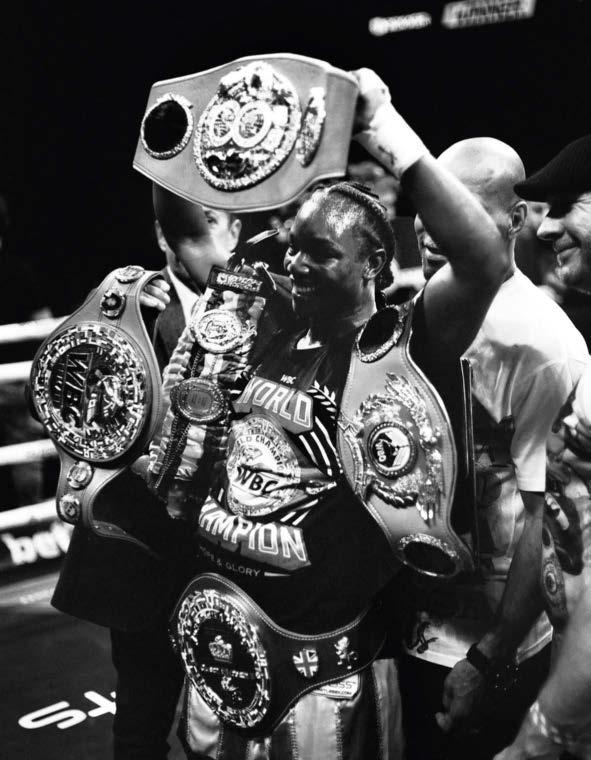
New Orleans’s indomitable queen of bounce music is on the mic and firmly in control
In Finland, rallying is king, winning is almost a birthright, and this young driver is heir to the throne
79 Fantasy island: why Hawaii is the epicentre of adventure for outdoor sports lovers
84 Room to manoeuvre: negotiating your way out of a sticky situation
87 Hips don’t lie: master the fullbody workout that is racewalking
88 Dicing with the devil (not): get on board with Dungeons & Dragons
89 Worlds apart: HTC’s Vive XR Elite headset has realities to spare
90 Fix up, look sharp: the specialist bike tools you need in your life
94 Essential dates for your calendar
98 Outdoors wisdom from Semi-Rad
44
Eyes
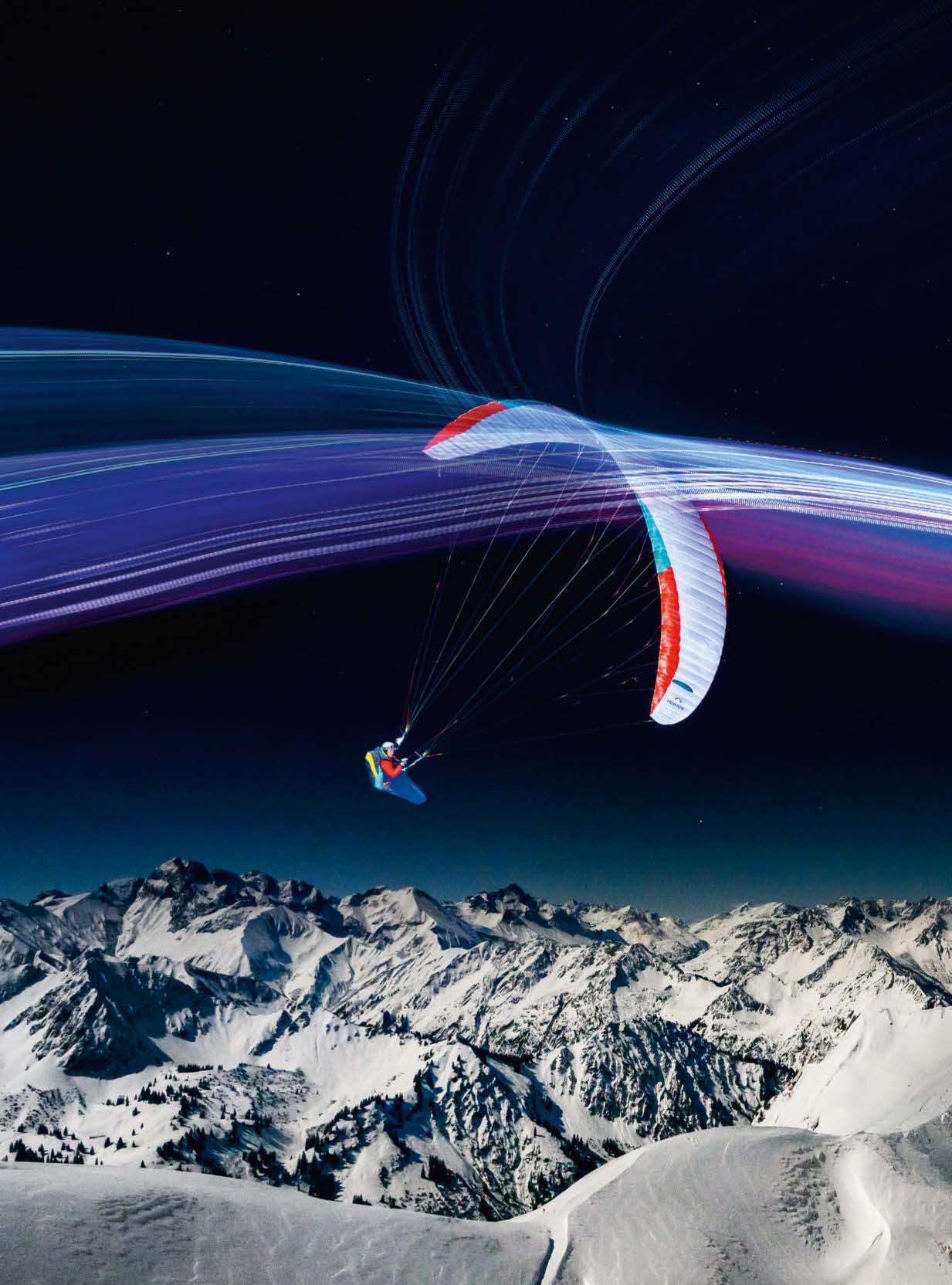
This month’s Gallery is an homage to the elements: air, water, fire and earth. We begin with aerial alchemy from paraglider Michael Lacher and photographer Adi Geisegger. Lacher’s magic is of the athletic kind, above the 2,224m-high Nebelhorn; Geisegger’s is a form of “light painting”, as he calls it, employing powerful flashlights, long exposure, and 320 LEDs on the trailing edge of the kite. A semi-final place in the ‘Masterpiece by SanDisk Professional’ category of Red Bull Illume was assured. adigeisegger.com; redbullillume.com
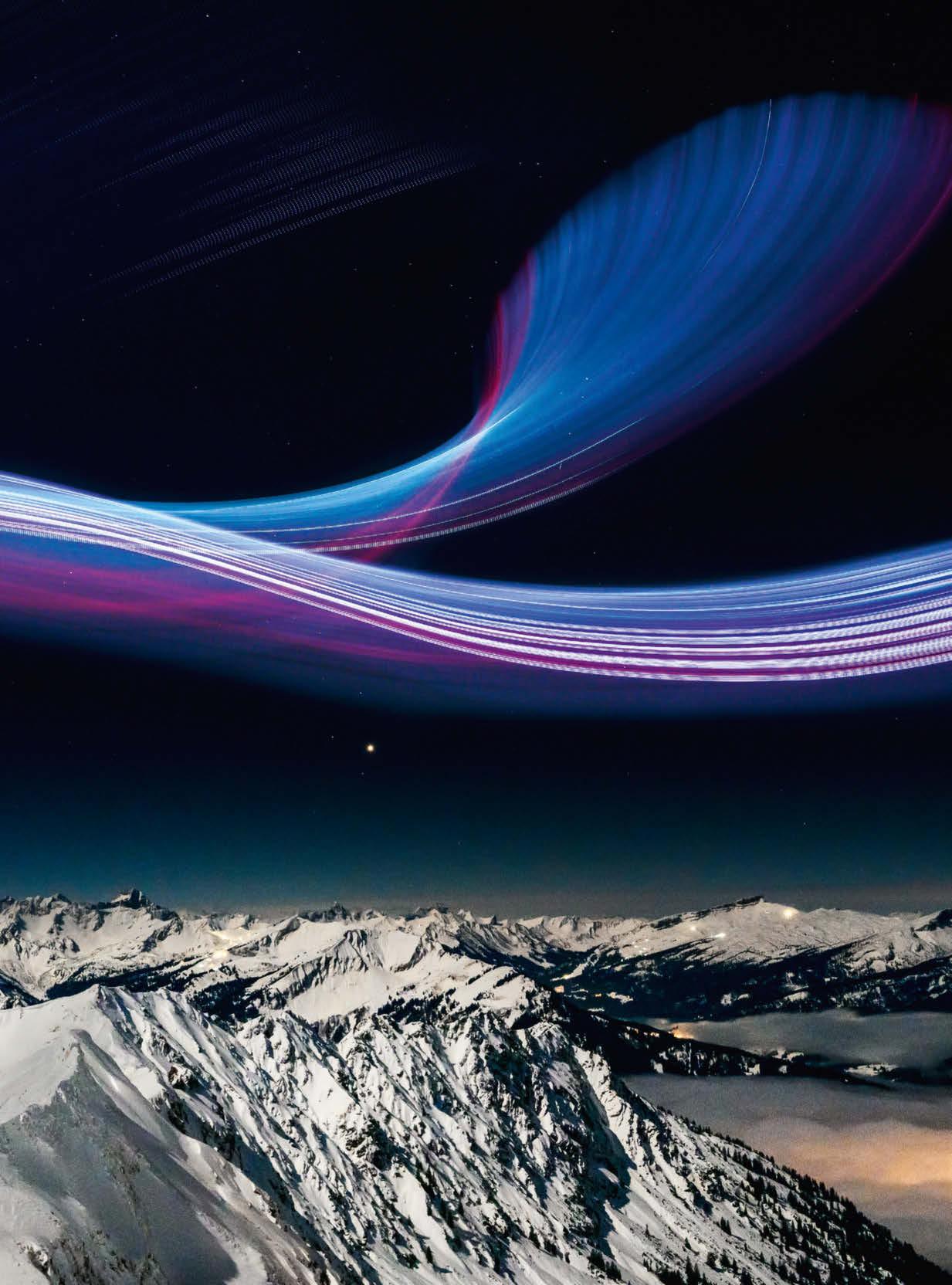

Hollow Tree. Greenbush. The Hole. If you’re thinking of ’90s rock bands, chances are you’re not a surf pro. These are waves in the Mentawai Islands, a chain that sits 150km off the coast of Sumatra and has been a surfing hotspot since the late ’80s. Last May, Red Bull took nine top board-riders, including Olympian Caroline Marks and 20-year-old Californian Dimitri Poulos (pictured), on a 19-day surf bender. For all the action, check out season two, episode one of People Watching on Red Bull TV. redbull.com
Having gained a reputation for awesome rope skills, skipping supremo Timothy Ho Chu-Ting knew his next stunt had to be lit. So, in May last year, the Hong Kong-born record-breaker – the first person to nail 500 skips in three minutes, in 2012 –decided to set the world on fire, starting with his rope and himself. The video for his ‘Fire Dragon’ trick (available to watch on the Glxbal Labz channel on YouTube) shows how the now 27-year-old did it. Don’t try this at home. Obviously. redbull.com


Welcome to ‘The New Dark Age’. That’s the name North Vancouver-based lensman Dave Smith gave his 2022 photo project – a meditation on the nature of change, the brooding beauty of the forest, and the deep-rooted dedication of those who ride its trails. Joining him was a line-up of local MTB talent that included Jono Lo, Bella Roelveldt and Nigel Quarless, a concept artist by trade, who also contributed to the project a moody illustration: an ancient, gnarled ‘Green Man’ holding a spade. Equally striking, this shot of Quarless in the saddle won a semifinal place in the ‘Playground by WhiteWall’ category of Red Bull Illume. Instagram: @dasmith; redbullillume.com
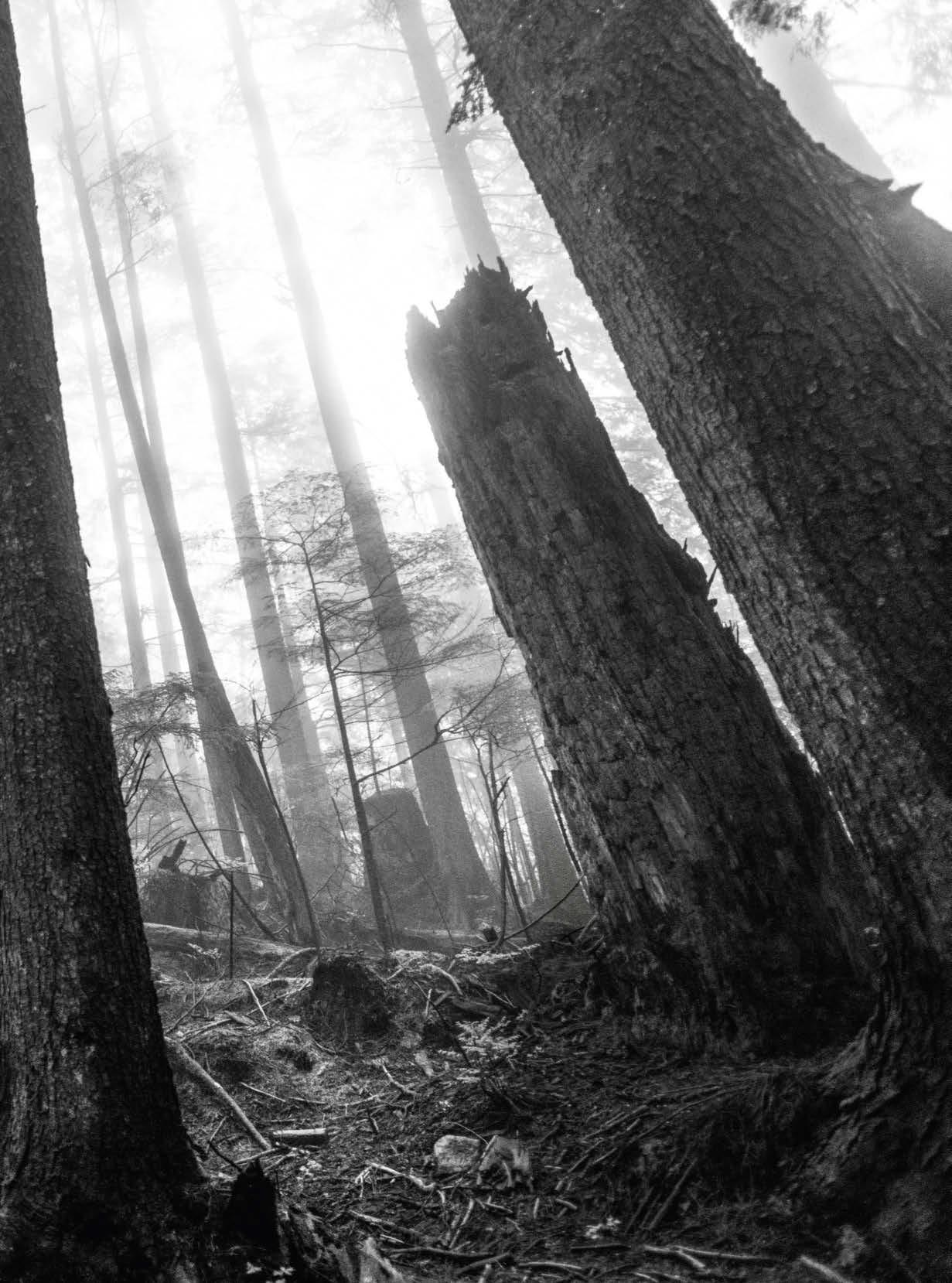
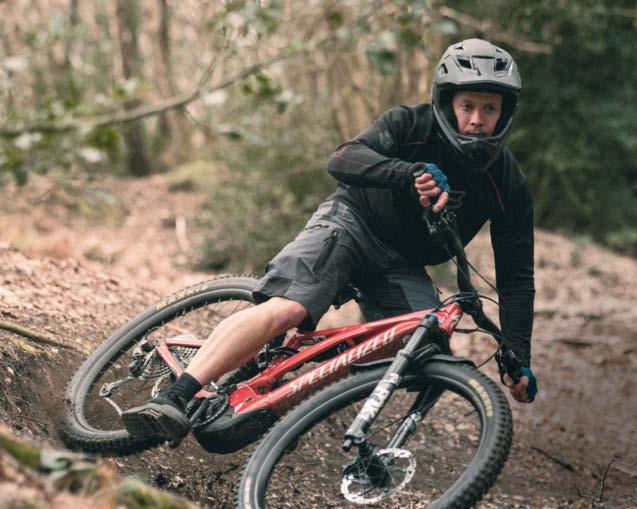
Muscle stimulation controlled by your mobile.
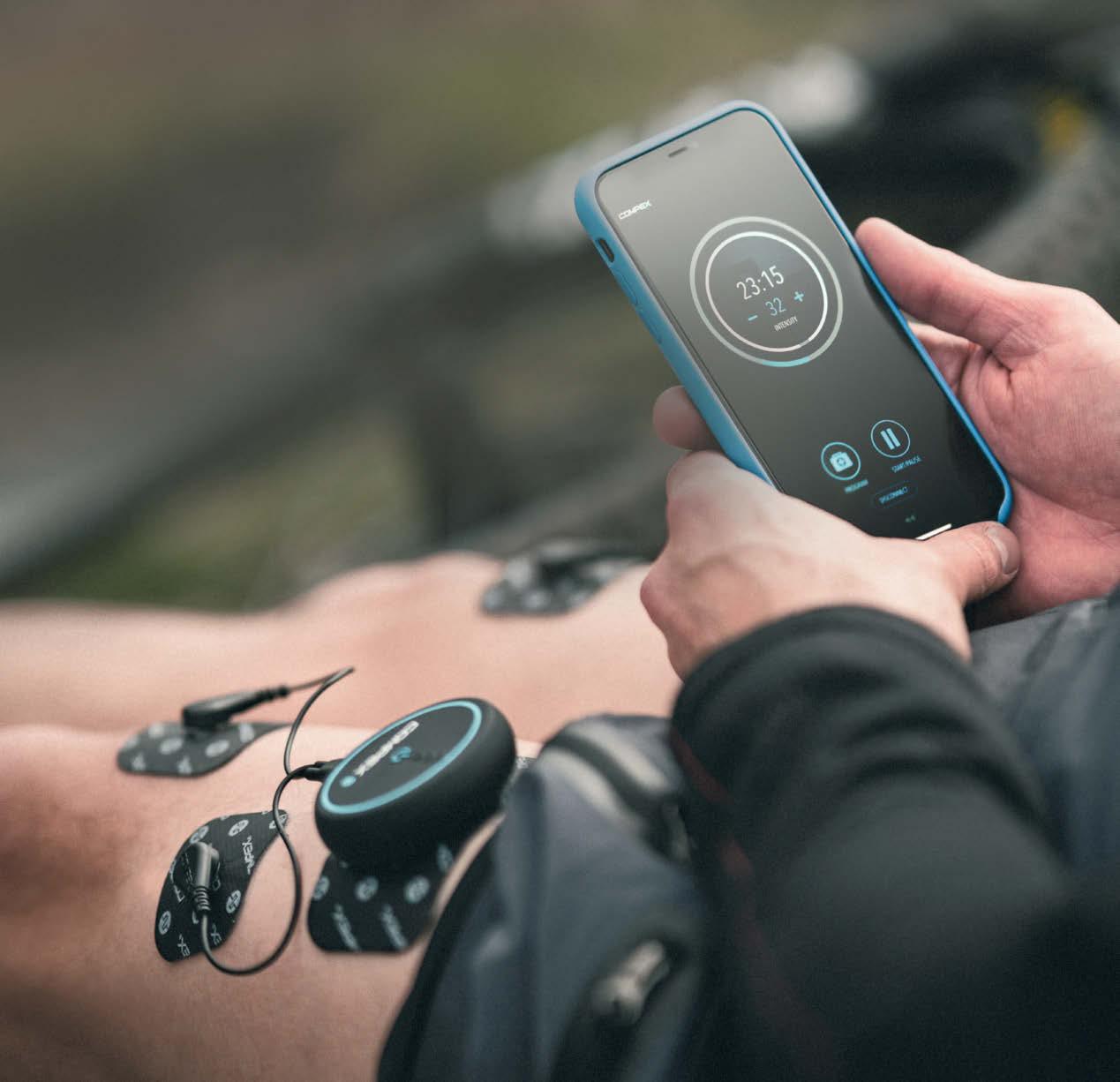

The influential broadcaster and DJ revisits four of Brit-funk’s finest moments
Gilles Peterson has been curating music – as a DJ, broadcaster and label owner – since 1979 when, at the age of 15, he operated a oneman pirate radio station from his shed in south London. On the latest album by STR4TA, his joint project with Jean-Paul ‘Bluey’ Maunick, Peterson pays homage to Brit-funk, a ’70s/’80s blend of jazz, funk and disco. “I wanted to celebrate that groundbreaking era,” he says. “The parallels with the political landscape of that time are poignant, and the moment of change we’re living in is reflected in this record.” Here are four of his Brit-funk favourites… STR4TASFEAR is out now; gillespetersonworldwide.com


Eyes Waterfalling (1982)
“There used to be this Brit-funk night at a venue [London club
The Venue, now defunct] right across the road from Victoria Station every Friday night, and because I lived in Sutton [35 minutes away by train] I’d be able to get to Victoria for around seven o’clock. The first group I ever saw there was Level 42. I was completely obsessed with them – by the age of 17, I’d seen them probably 20 times.”

Bra (1972)
“I remember first hearing this when I was more sophisticated with my music tastes, when I was already an established DJ and beyond being a Brit-funk teenager infatuated with Level 42. I didn’t realise Cymande had come before many of the groups I loved. Not only were they a foundation for Brit-funk but for other movements, too. You need gate-openers for any movement to happen, and they were certainly one of those.”
Love Money (1980)
“This song was really popular with American DJs and became a classic in New York clubs. The TW in the name of the artist stands for Tony Williams, who was a DJ on BBC Radio London, where I DJ’d after doing pirate radio. But I didn’t realise he did the reggae show when I was there doing the jazz show, and sadly he passed away a couple of years ago, so I never got to talk to him about it.”

Pete’s Crusade (1980)
“Light of the World were the Earth, Wind & Fire of Brit-funk. Founding member Bluey [later of acid-jazz group Incognito] was the first interview I ever did on pirate radio, when I was 15. I wrote letters to all my favourite groups and no one answered except him. He came to my house and did the show, which I recorded in my shed with aerials my dad helped me put up. And today Bluey’s my partner in STR4TA.”
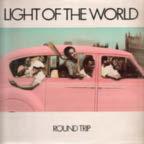
This jeweller uses old phone handsets to give rings of a different kind
Such is the time we spend glued to it, our mobile phone might seem like our most precious possession. But it’s inevitable that as technology advances, today’s beloved handset will end up gathering dust at the bottom of a drawer.
For one jewellery designer, though, old phones, computer keyboards and video-game controllers are quite literally a goldmine. Eliza Walter’s London-based brand Lylie makes jewellery using precious metals recycled from e-waste, and in 2017 it became the first in the UK to be granted a specific ‘salvaged’ hallmark.

“E-waste refers to any electrical item that has ended
its life,” says the 29-year-old, whose sustainable ethos extends to her designs, which are inspired by the natural world. “It’s a huge problem because these objects have a built-in obsolescence. They’re designed to last for two or three years and then need to be replaced.”
Having first learnt about e-waste while studying for her GCSEs, Walter became fixated on the potential of using this untapped resource to build a more sustainable jewellery industry. “Because it’s so difficult to trace the source of things – precious metals in particular – there are some very unethical practices
in the jewellery industry. These items that are meant to represent love and devotion are actually representing a great deal of suffering.”
According to Lylie, a typical mobile handset contains approximately 0.2g of gold, and the average wedding ring requires at least 3g, so it would take 15 old handsets to create a piece of jewellery that will last a lifetime and beyond. Precious metals are concentrated in the motherboards of e-waste objects, and Lylie’s refiner uses an extraction process known as hydrometallurgy, which shreds the material and uses chemical baths to strip away these valuable elements. The happy by-product of this is that the process also separates out all the other, less precious but recyclable materials such as ceramics and plastics.

All this might sound complicated, but the reward is great: one incredible stat shows that if a tonne of the earth’s ore were mined using traditional methods, you’d end up with less than 30g of gold, whereas a tonne of e-waste would yield 10 times that amount. And although some customers might perceive e-waste gold as inferior, Walter asserts that it’s equally valuable, the only difference being that it’s had “past lives”.
Lylie has expanded its salvaging operations to include dental waste, and its gold exchange allows customers to send in old jewellery for recycling. Not only gold but also lab-grown diamonds and man-made gemstones are key to a more sustainable industry, Walter says, adding that e-waste mining looks set to become even greener.
“The future is actually through fungi,” she says. “It’s so unbelievable. It’s fungi that gets taught how to eat the plastics to separate the metals. That’s definitely the frontier of metal extraction.” lylies.com
Data mining: (above) Eliza Walter; (top) a old phone’s motherboard alongside a Lylie necklace made from recycled e-waste gold ELIZA WALTER
Meet the community group redressing a lack of diversity in off-road running
Sonny Peart had often noticed he was the only person of colour on the starting line of an ultramarathon, but he’d never given it much thought. “For me, that was fairly typical,” says the London-based university lecturer. “I was the only Black person in my class at school, in my class at university, at my first job. I’m used to being in that kind of situation.”
But after conversations with fellow Black runners in the aftermath of George Floyd’s death and the resurgence of the Black Lives Matter movement in 2020, Peart realised the problem was widespread. Aiming to boost diversity in the overwhelmingly white world of trail running, in July that year he and seven other Black and bi-racial runners co-founded community and campaigning group Black Trail Runners (BTR).
experience. “Neurologically, being in green spaces is good for us,” says Peart, who has been running for more than a decade. “You get to go to places people don’t normally see unless they’re on foot, and you have to pay attention to the terrain underfoot – it activates a lot more of your cognitive resources.”
Although running is often seen as the most democratic form of exercise, Peart says this is an oversimplification – especially when it comes to trail running. “It boils down to access, skills and representation,” he explains. “Yes, you can get a pair of cheap trainers and go out the door, but you can’t do trail running like that and do it safely or confidently.”
“I did a quick survey of the websites of races that I had run, and I couldn’t find a single picture of a Black runner,” says Peart, now 54. “It makes you feel unseen.” According to BTR’s data, only 0.7 per cent of trail race entrants in the UK in 2021 were Black. That’s a lot of people missing out on the benefits of running trails.
Taking place off-road – in woodland, mountains and coastal areas – trail running not only requires different skills, gear and knowledge to pounding the pavement, but it offers a completely dissimilar

Black Trail Runners, which was awarded charity status in April 2021, is working hard to change that. The group offers guided social runs with travel expenses covered, as well as taster events with workshops on kit and navigation; it also pays race entry fees and runs a free kit-rental scheme. Last year, its 8,500 (now 8,700) members on Strava ran 8.5 million miles, proving, Peart says, that the appetite is there once barriers are removed: “Running with people who share your lived experiences is a really enjoyable thing to do.”
This May, BTR will stage its first event, Black to the Trails, with 1K, 5K and 10K races on Dunstable Downs in the Chiltern Hills in Bedfordshire. Given the importance of representation, the fact that 70 per cent of entrants are people of colour – 100 times the aforementioned 2021 UK average – is a massive achievement. And photos from Black to the Trails, says Peart, “will look like no trail race event we’ve seen in the UK before”.
For more information, go to blacktrailrunners.run and blacktothetrails.co.uk


Need to shift a bulky load? The Cargo Hybrid is the environmentally friendly solution you‘ve been looking for: simple, easy to ride and endlessly versatile. Powered by Bosch‘s fourth generation drive system and featuring an EPP foam carrier, it‘s the best excuse yet to ditch the car.
CUBEBIKESUK / www.cube-bikes.co.uk
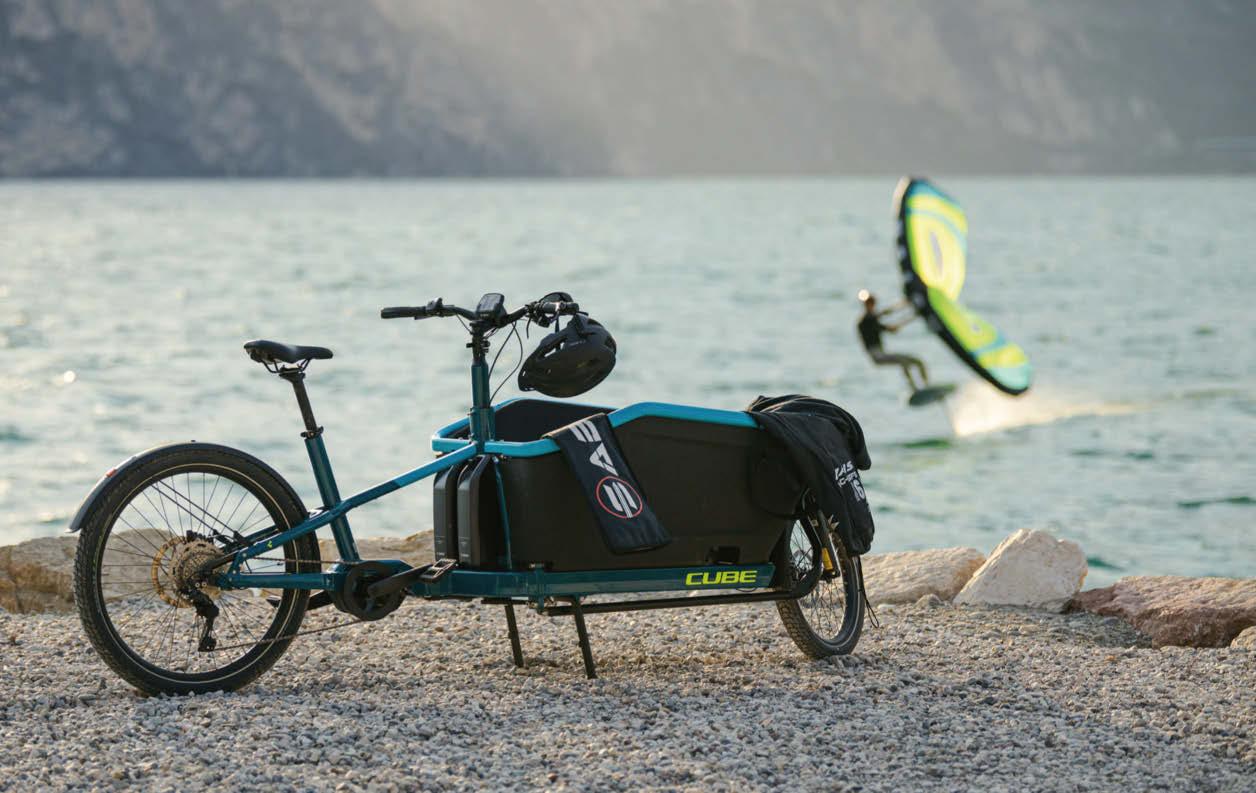 CUBE CARGO HYBRID
CUBE CARGO HYBRID
How a ‘professional listener’ from London found true aural freedom on an island the size of Wimbledon Common
For Anton Spice, the Isle of Muck is the most beautiful place on the planet. The smallest of the Small Isles – an archipelago located in the Inner Hebrides, off the west coast of Scotland – Muck is just a 45-minute walk from end to end. Mostly flat, dotted with bays and bothies, the island has a population somewhere between 30 and 40, but no post office, no church and no pub.
And yet it was here, in the absence of city hustle and bustle, that writer and music editor Spice had a new kind of sonic experience. In early 2020 Spice, who’s normally based in London, took a sabbatical from his job and booked a cottage on Muck for a two-month digital detox with his partner. But as the pandemic hit, the pair soon realised they would be spending much longer in this tiny enclave.
To occupy himself, Spice turned to a handheld recorder he’d packed with the vague intention of learning to make field recordings. Initially, he spent a month capturing 10 minutes of audio every day at the same spot, but then pressing the record button became more instinctive. While some of the clips honed in on details – the specific call of a snipe or lapwing – others were “very panoramic”, says Spice. “They’re three-dimensional in a way that a photo isn’t. You’re hearing things that are happening way out of shot.”

Isle be there: (from top) an atmospheric shot of Muck; this image and more feature in the pamphlet of the limited-edition set of Echo Location; the cassette

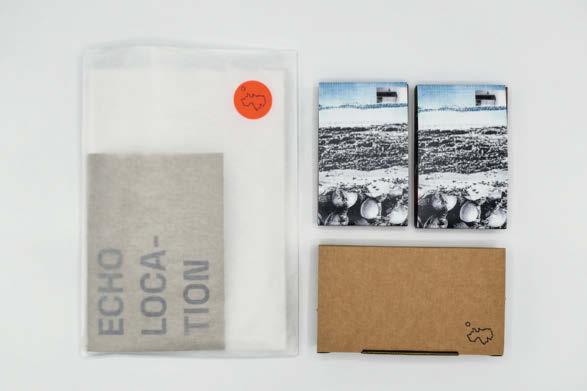
Capturing sounds of the wind, waves, animals and farm life, the recordings offered Spice a more intimate and meditative way to experience his limited environment and “the infinite detail that emerged – you could go deeper into the space around you”. After 10 years in online music journalism and ‘professional’ listening, it was liberating: “This felt very pure and not compromised by others’ needs and desires, and trends. It gave me a sense of wonder that I hadn’t felt for a long time when listening to something.”
When he returned to London five months later with hundreds of hours of unique sounds, Spice sent an edited sample pack to musician friends from all over the world. There was “no brief and no pressure”, just an invitation to take Muck’s sonic landscape
as inspiration and interpret their own imaginary island from what they could hear.
He was sent back eight tracks from seven artists including James Gardner, a modular synthesist from New Zealand; Australian-born electronic artist Penelope Trappes, sound designer Udit Duseja, and DJ Raff from Chile. Last year, Spice compiled these on an album titled Echo Location, which he hopes will encourage people to tune in more closely to their sonic environments.
“The sounds were so important to my experience,” says Spice. “There’s something restorative and transformative about paying attention to detail and taking a step out of the rhythms imposed on us.”
Echo Location is available at echo--location.bandcamp.com
Inspiration for the otherworldly design didn’t come solely from the environment, but also from the wisdom of “ancient systems of architecture”, says Bhatia. “People in olden days made buildings very close to nature. From the types of materials they used, everything was locally sourced. Now, you see skyscrapers that are just glass buildings, or constructed mostly from concrete. I made Symbiotic Architecture to create an alternative vision.”
These images only exist within an AI rendering, but Bhatia’s back-to-nature ethos is being mirrored by forwardthinking architects worldwide. On the Danish island of Læsø, houses are being clad in native seaweed – the revival of a centuries-old tradition. In England, a house brick has been created that provides nesting for bees. And Italy is home to the ‘Sunflower House’, a responsive building that turns to face the sun for maximum solar energy efficiency.
One day, says the creator of the surreal tree-house pictured above, humans might live in buildings that grow and breathe

Will humans in the future live inside trees? This is the question that Manas Bhatia, an architect and computational designer from India, asks with his AI project Symbiotic Architecture, which depicts a series of ‘living’ apartment blocks with the appearance of giant, hollowedout redwood trees. Visualising a world where we could leave today’s houses of concrete and brick to live in breathing, growing structures, Bhatia conceived these concept towers as a challenge to architects to think more creatively and design with the planet in mind.
Symbiotic Architecture was created using the artificial intelligence (AI) programme Midjourney, which converts written prompts into dreamlike architectural models. Inspired by Hyperion – the world’s tallest known living tree, which stands in California’s Redwood National

Park – Bhatia imagines how humans could subsist within such large natural structures. “I’ve always been fascinated by how small creatures create their dwellings in nature,” he says. “Ants make theirs with intricate networks in the soil. Imagine if humans could create buildings that grow and breathe like plants do.”
“There’s a tremendous amount of research going on,” says Bhatia, who’s based in New Delhi. “Materials such as mycelium [fungal fibres] and agricultural waste are beginning to be used. A lot of things are happening. We’re not trying to achieve the exact design that the AI has given us but to encourage systems that could realise its vision one day.”
As the climate crisis becomes ever more urgent, out-of-the-box thinking like Symbiotic Architecture will become more vital. “The construction industry alone contributes a large portion to global warming, and people are already starting to realise that if they don’t start now they’ll never be able to recover the planet,” says Bhatia.
“It’s definitely the duty of an architect to design buildings in ways that are eco-friendly and respect the planet.” For more, go to Instagram: @manasbhatiadesign





When her Olympic dreams were dashed, the 33-year-old athlete devised an even bigger challenge: completing 150 consecutive marathons across the breadth of Australia
Words JESSICA HOLLAND Photography RYAN KENNEDYWhat do you do when your dream of becoming an Olympic marathon runner is thwarted by an injury in one qualifying race, ferocious headwinds in another, and a global pandemic that resulted in the third being cancelled? For 33-year-old distance runner and nutritionist Erchana Murray-Bartlett, the answer was to come up with a challenge even more ambitious and meaningful.
The Australian athlete grew up running along goat tracks in the wine country of Victoria, and this helped spark a “passion for wildlife, and a dream to run the length of the country”. Australia’s extinction crisis was on her mind; last year, the nation’s totemic koala was added to the endangered list. So she decided to quit her job, drum up support, and run from the mainland’s ‘tip’ (Cape York) to its ‘toe’ (Melbourne). In doing so, she’d run a marathon’s distance every day for 150 days –around 6,330km in total – breaking the previous women’s record (106). Most importantly, she aimed to raise AU$10 per kilometre for conservation group Wilderness Society.
In August, accompanied by her partner in a camping trailer, MurrayBartlett set off on her Tip to Toe 2022 challenge. Taking in 6,000 calories a day to get her through the daily four-hour run, she endured croc-filled rivers, injuries, and periods of intense self-doubt.
Less than six months later, she arrived in Melbourne, her fundraising goal more than doubled and a new world record under her belt. The Red Bulletin caught up with Murray-
Bartlett the following day, after just a few hours of sleep thanks to an early appearance on morning radio…
the red bulletin: Congratulations! How do you feel?
erchana murray-bartlett: Pretty overwhelmed, in a good way. My body’s excited because it’s the first day in more than 150 days that I haven’t been out there hitting the pavement at this time.
What inspired you to embark on such an intense challenge?
I wanted to see as much of Australia as possible. I also want to motivate others to run outdoors and immerse themselves in Australia’s outback and parks, so all my runs were public. I used social media to invite others to join me – sometimes it’d be just one person, yesterday it was 100. Another ‘why’ is my cause. Australia is a world leader in biodiversity loss; we’ve got almost 2,000 species on the endangered list. We also have deforestation in line with the Amazon. I wanted to bring attention to this. And my personal goal was to break the world record – after a few failed attempts at doing something on a global level, that felt good.
Did you have to watch out for dangerous animals?
It’s pretty remote up north, and we had to wade through rivers. The water is deadly: there’s marine stingers and sharks – we saw some bull sharks –and crocs. We had to be careful.
What were the biggest hurdles along the way?
I had three injuries in my first month. I was warned this would be the time
my body breaks down the most. I had a calf injury and changed my running technique to ease the pain, but that immediately caused an overuse injury in my [shin], which was even more painful. Once I’d strapped that up, my quad went, on the same leg. It was an excruciating two weeks. I was surprised I could get through it. My physios were astounded that the body can heal while under so much strain.
How did you cope mentally?
I got brain fog straight away and couldn’t remember anything. To be honest, that’s still here today. I’ve also been getting very emotional over small things, due to the fatigue.
Did it help when others joined you? Absolutely. There was a time in rural Victoria when I reached out and said, “I’m really struggling, I need some love and support,” and the next day around 20 people rocked up at the start line. I was very grateful for that.
Has the experience changed you?
I’ve learned to set boundaries, and that I can push myself infinitely further than I thought. I’ve learned to lean on the kindness of strangers; in terms of offering help and support, people are so much greater than I ever gave them credit for. I’ve gained a lot of confidence in myself, and a greater appreciation of the Australian outdoors and wildlife. I also have a better understanding of the severity of the cause I’m running for. It has reinforced how important it is to act.
What’s next for you?
I’m going to take a break to process and reassess, rather than jumping straight back into real life. I’m superinspired to work in the conservation space, going forward. Tip to Toe has shown me there’s so much you can do.
What would you like people to learn from your example?
You’ll be surprised at how much you can do, whatever you set your mind to. I didn’t know I could run five marathons in a row, let alone 150. I just put one foot in front of the other and gave it a go. If you try, you’ll definitely surprise yourself. Instagram: @_erchana_

“I didn’t know I could run five marathons in a row, let alone 150”Becky Hutner
When Becky Hutner first entered the film industry, making documentaries about climate change weren’t part of the plan. The Toronto-born filmmaker was making a name for herself as a content creator in the travel and lifestyle industries when, in 2011, she took an editing job on a documentary that would change her career – and her entire world view – for ever.
“I worked on a film called Revolution about climate change, the collapse of the oceans and the mass extinction we’re going through, and it knocked me sideways,” says Hutner, 42. “I truly went through a period of grief, and I’ve seen the world through a sustainability lens ever since. My priorities shifted, and I started looking for a way to use my filmmaking skills to contribute to the narrative around the issue.”
Hutner’s search ended when, two years after moving to London in 2015, she met Amy Powney, the protagonist of her debut feature, Fashion Reimagined. A young fashion designer with a fascinating backstory, Powney was raised off-grid in rural England by activist parents, so she was acutely aware of her industry’s impact on the environment. When her brand, Mother of Pearl, was named joint winner of the 2017 BFC/Vogue Designer Fashion Fund, Powney decided to use the £100,000 prize to create a line that was truly sustainable, right back to the cotton fields and wool farms producing the raw materials.
It’s here that Fashion Reimagined joins Powney on her exploration of the fashion industry, looking at its environmental impact through her
unique gaze. The work went on to be selected for numerous international film festivals and nominated for four awards, including Best Debut Director (Feature Documentary) at the 2022 British Independent Film Awards. Here, Hutner tells us what first inspired her to share Powney’s story, and why we all have a responsibility to the planet…
the red bulletin: Why did you choose to make your debut film about Amy Powney?
becky hutner: I first met Amy in 2017 when I was assigned to cover the Vogue Designer Fashion Fund. She said she was about to embark on this mission to create a sustainable collection at Mother of Pearl, and that was a lightbulb moment for me. I knew this was the story I had to tell, and how I could contribute. I hadn’t met anyone else doing what Amy was setting out to do.
Why was the collection at Mother of Pearl so different?
It’s hard to believe in 2023, when there are many more sustainable fashion designers, but in 2017 I didn’t know of anyone else trying to create a collection that was completely traceable back to the cotton fields and wool farms. Amy had such high aspirations and such a holistic view of sustainability, and she wanted it to be totally traceable and organic, with resources, chemicals and the water footprint kept to a minimum. Also, animal welfare had to be sound right across our supply chain, with a labour force that was paid a fair wage. It was an incredible list of standards, and very ambitious.
How important was Amy’s off-grid background to your story?
Within a few minutes of meeting Amy, you know she’s special and different. Her story – a girl grows up in a caravan with no money and no connections but ends up taking on the fashion world – is so strong and universal. She made an incredible career for herself, from starting as an intern at Mother of Pearl to becoming creative director and joint owner. That’s so impressive. Then she decided to revolutionise the whole industry.
It’s a story about rebellion, right? Absolutely. Amy is a rebel in every possible way, and she’s not afraid to speak her mind. I love her for it.
There’s the sense of responsibility to the greater good, which is common to your work and hers… It was an overarching theme for this whole project. For several years, I’ve felt guilty about not using my skills as a filmmaker for the greater good and not contributing to this issue, which is so urgent. Getting to tell this story was a gift from the universe, so I felt a crushing responsibility. It felt like a huge risk for Amy, too – she was so generous with her time, and this film would have a big impact on her. I had a huge responsibility to tell the best version of this story.
What did you learn from making this film?
I was in the fashion world for years, yet I had no idea about the scale of its environmental impact. It’s a major contributor to climate change, and the foremost source of ocean microplastics. We think of plastic bottles, bags and fishing nets, but our synthetic clothes shed during washing and that plastic ends up in the ocean. Then there’s the way garment workers are treated, and the fact that fashion has the second highest fresh-water consumption of any industry. We’re producing 150 billion garments per year, and three out of five end up in a landfill within a year. These stats are unbelievable. I continue to learn every single day. Fashion Reimagined is in cinemas now and available on Sky Documentaries and streaming service NOW from April 9; fashionreimaginedfilm.com
One radical clothes designer is attempting to change the way the fashion industry works, and this filmmaker is using her own platform to pass on the environmental message

“Getting to tell this story was a gift from the universe”
Forget the Wimbledon trophy, the Ashes urn, or even the modern Olympics – the oldest actively contested prize in international sports is the America’s Cup. Since 1851, the cup, informally known as the Auld Mug, has passed hands between the victors of what has become yacht racing’s pinnacle event – a test of boat design and construction followed by an open-water race between the cup’s defenders and its challenging team (or teams). These
merely entering the race can cost a team the GDP of a small country. And yet there’s no prize money, simply the prestige and pride of possessing this trophy and the right to host the next race. All this for a trophy that was valued at £100 when it was frst contested.
It’s doubtful that, in 1848, Garrard & Co of London knew the import of what they were building. To the offcial Crown Jeweller, the commission would have seemed trivial: an off-the-shelf, ornate sterling-silver ewer (a jug, in layman’s terms), likely one of many made at the same time. In today’s money, those 100 sovereigns would fetch somewhere around £17,000 – a handsome sum, but hardly extravagant. It was bought by Henry William Paget, a British Army offcer who’d fought in the Battle of Waterloo, who in turn gifted it to the Royal Yacht Squadron (RYS). They offered the £100 Cup, as it was called at the time, as the prize for their 1851 Annual Regatta – an open-entry yacht race around the Isle of Wight, off England’s southern coast. Their intention was to rekindle interest in yacht racing and attract American contenders. It worked.
On August 22, 1851, 15 yachts, cutters and schooners assembled on the waters of the Solent, off the isle’s seaport of Cowes. The 53-nautical-mile (98km) circumnavigation course was called The Queen’s Track, and Queen Victoria herself was observing from the nearby royal yacht. One of the vessels in particular stood out: a sleek, 30m-long schooner, America, commissioned by a syndicate of fve New York Yacht Club (NYYC) members to show off US shipbuilding excellence. They hadn’t travelled so far with the intention of winning such a paltry prize, but rather in the hope of entering into yacht races with high-stakes wagers in the realm of tens of thousands of pounds. However, after sitting on anchor for weeks with no takers, the best offer they got was this open regatta. So, they entered with an eye towards besting the home-advantaged Royal Yacht Squadron. It worked.

The starting gun sounded, and almost 11 hours later America reappeared on the horizon.
Legend has it that Victoria queried her signal master about whether the yachts were visible. He replied “Yes” and that America was leading. Victoria, it’s said, then enquired about the runner-up. His answer established the tone for today’s
The tale of a £100 cup that, for centuries, billionaires have risked their fortunes to attain
DAVID SCHMIDT
To shoot this high-resolution photo of the America’s Cup, the Royal New Zealand Yacht Squadron kindly allowed photographer Rick Guest access to its headquarters.

“You come up a staircase into this large atrium and there it is, in a box on this plinth,” says Guest. “And it’s really big.” This caused logistical challenges for his photographic technique, known as multifocal compositing. “You shoot lots of photos at a very shallow depth of field, but by pushing the focus back through the object in lots of slices you capture all of it with the best part of the lens,” he explains.
“Then you composite the images so that it’s pin-sharp front-to-back. There are about 80 frames in that shot.” The result is an image of the trophy at a level of detail never before captured.
“The cup is incredibly impressive,” he says of being in its presence. “Part of the joy is that it’s not some modernist take in the shape of a sail or something. It’s a proper trophy, as it should be.” And there was one further challenge. “I assumed it was just a fire alarm,” he says of the siren that went off mid-process, “but then this wooden box dropped from the ceiling, covering it, like something from Mission: Impossible I’ve got a couple of shots with it going through the photo frame. But the Kiwis treat the cup with such incredible reverence. You can see they’re in awe of it.” rnzys.org.nz
zero-sum game. “Your Majesty, there is no second.”
The RYS’s £100 Cup headed to Manhattan, but the schooner America remained in England, fipped just 10 days later for a proft of $5,000 (around £162,000 today). She would change hands and names many times over the next 90 years, even serving as a blockade runner in the American Civil War, before meeting an inglorious fate in a nondescript US shipyard in 1942 when a shed roof collapsed on her during a heavy blizzard. Three years later, she was scrapped. The destiny of the £100 Cup, however, would prove far less ignominious.
Once home, the syndicate members –the NYYC’s frst commodore John C Stevens, his brother Edwin A Stevens, vice commodore Hamilton Wilkes, civil engineer George L Schuyler and winery heir J Beekman Finlay – initiated the process of giving their prize to the stillnascent yacht club. However, a legal document – a deed of gift conveying
ownership of the item, plus any governing terms and conditions – was needed to cement the deal. Rumour holds that the cup spent the next six years rotating between syndicate owners’ homes, with talk of even melting it into fve medals.
In 1852, Schuyler sent John Stevens a package containing the deed of gift. Dated May 15, 1852, it was signed by three of the syndicate members. John and Edwin Stevens were asked to add their signatures and present the completed deed to the NYYC. However, for reasons unknown, Commodore Stevens failed to do so before his death in 1857. His copy of the America’s Cup Deed of Gift (DoG), considered the original artefact, remains lost.

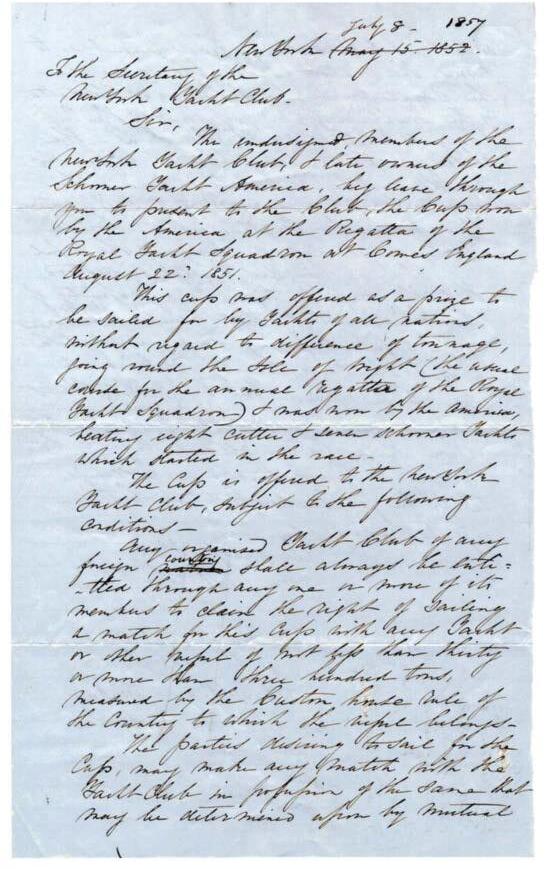
Today, the cup is encased in bulletproof glass
On 37 West 44th Street in Midtown Manhattan resides the New York Yacht Club Building. Built in 1901 and designed by Whitney Warren – the architect behind the city’s fabled Grand Central Terminal – it’s a work of art, but in its basement lies an equally valuable heirloom, the America’s Cup Deed of Gift. Handwritten on two sheets of bonded letter paper, in copper ink that has rusted to brown over time, the document is stored in a basic stationary binder – “People expect it to be in a leather-bound book,” the archivist tells us – and can, surprisingly, be handled with bare hands (gloves increase the risk of tearing). The NYYC is resolute that this is the original DoG; however, the scoring out of the original date supports the historical anecdote that this is Schuyler’s personal copy (he rewrote the DoG twice more, in 1882 and 1887 – all three are in the same binder). Whether this really is the original DoG, it’s irrefutable that this letter laid down the rules of the world’s longest-running yacht race. The NYYC says it hasn’t allowed a photographer into its archive since 1901, but it kindly shared this high-resolution image with The Red Bulletin. nyyc.org
Just one month later, Schuyler presented his own copy of the DoG to the NYYC, slightly edited and re-dated July 8, 1857. The club accepted Schuyler’s facsimile and began notifying overseas yacht clubs that the “Cup won by the America” (the original Deed’s only mention of an ‘America’s Cup’) would be contested in a perpetual “challenge cup for friendly competition between foreign countries”. Sailing would never be the same again.
It would be 13 years before any foreign yacht club accepted the challenge. After that, the NYYC proceeded to defend the cup for the next 132 years, authoring sports history’s longest winning streak via exceptional sailing
and distinctly partisan rules (not least a clause – added in 1882, following the frst four America’s Cup contests – that stated that “vessels must proceed under sail on their own bottoms to the port where the contest is to take place”; a clear handicap for challengers who had to manufacture yachts sturdy enough to cross the Atlantic, while the home defenders were free to construct much lighter yachts). With each victory, the trophy’s gravitas grew.
One of the more particular aspects of the America’s Cup is that, unlike most other sports, there is no governing body. Instead, according to the wording of the DoG: “The club challenging for the cup and the club holding the same may, by mutual consent, make any arrangement satisfactory to both as to the dates, courses, number of trials, rules and sailing regulations, and any and all other conditions of the match.”
In other words, the ‘Defenders of the Cup’ and the ‘Challenger of Record’ (the frst yacht club to challenge the holders) must agree amongst themselves as to the rules – known as the Protocol – of each upcoming competition. This has led to some heated disputes, such that independent juries have been appointed to arbitrate negotiations – the independence of those juries sometimes even being called into dispute. Frank Packer, Australian media tycoon and chairman of the Australian syndicate that challenged the 1970 America’s Cup, likened protesting to the New York Yacht Club to “complaining to your mother-in-law about your wife”. And should the two teams fail to reach a compromise, the rules default to those contained in an 1887 revision of the Deed, as has happened twice in history (1988 and 2010).
And what if interpretation of the Deed’s own wording – written as it is in the legalese of its day – should fall into contention? As a registered trust document of the State of New York, disputes are superintended by no less than the New York Supreme Court. And if that doesn’t settle it, the matter goes to the New York Court of Appeals, the state’s highest court. Yes, spats over this trophy have been taken this far, and at massive expense.
But then, this is a contest that over its 166 years has drawn a fabled roster of business titans to stake their fortunes and reputations in pursuit of this silver
ewer. Few have won it. Scottish self-made tea merchant Sir Thomas Lipton famously lost the challenge fve times; Sir Thomas Sopwith – the aviation pioneer behind the Royal Air Force’s most famous WWI fghter biplane, the Sopwith Camel – entered and lost twice; even Ellison’s Oracle team suffered three defeats (although his 2010 victory was achieved under the 1887 Deed of Gift rules).
The Auld Mug, too, has experienced its own ups and downs. In 1997, protester Benjamin Peri Nathan entered the Auckland clubhouse of the Royal New Zealand Yacht Squadron (RNZYS), then reigning defenders, and asked to see the trophy. He carried a shoulder bag containing a sledgehammer. Smashing through the relic’s glass case, he connected steel with silver multiple times, nearly destroying the cup. It was sent back to Garrard & Co in London to be restored, the work taking three months.
The cup is now back with the RNZYS (they won it again in 2017 and retained it in 2021), and its current custodians have ensured the same fate can never befall it again. Today, the cup is encased in bulletproof glass, with a safety shield that drops down the second the alarm sounds, and it is only handled while wearing white gloves.
As the trophy has grown in notoriety, so too has it in physical stature. Originally 69cm tall and weighing 3.8kg, these days it towers at 1.1m and weighs almost 14kg. Two additional tiers have also been added to its pedestal to accommodate the expanding roll call of winners engraved onto it. The cup’s original mahogany base, too, has been replaced by a carbon-fbre one, the whereabouts of the original unknown.
Today, when the cup ventures out into the world, it travels in a manner beftting an object of such storied history – in frst or business class in a bespoke Louis Vuitton trunk gifted on its 150th birthday, in 1998. And it does travel.
Since 1997, the America’s Cup has been contested on European and North American waters, as well as off Bermuda and New Zealand, and has traded hands three times – to the Swiss (2003), USA (2010), then back to the Kiwis (2017).
Not bad for a 175-year-old relic.
To see the high-resolution photos in magnifed detail, scan the QR code to head to redbulletin.com
Photographer KEITH LADZINSKI accompanies the world’s top climbers as they attempt their daring feats. Here, he tells us the stories behind his shots, from a remote iceberg in Greenland to a surreal lunar landscape in China
As told to DAVID MAYER
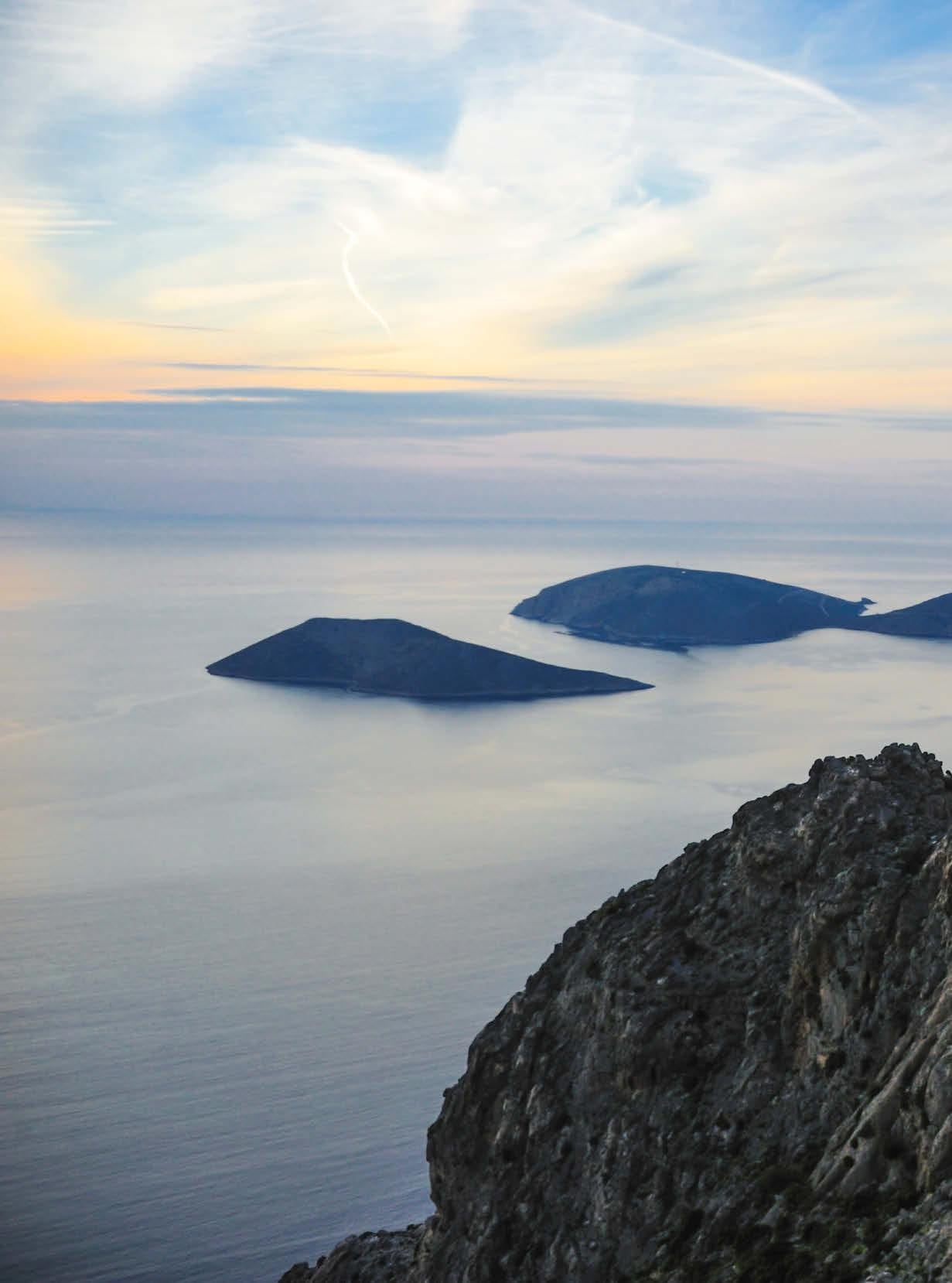
Alex Honnold, USA. One of the world’s most audacious and accomplished free soloists. Kalymnos, Greece
“Unique limestone formations, stunning views and all the sunshine you could ask for... The island of Kalymnos, off the southwest coast of Turkey, is a total paradise for rock climbers. Alex and I discovered this spot while exploring the area on scooters.”
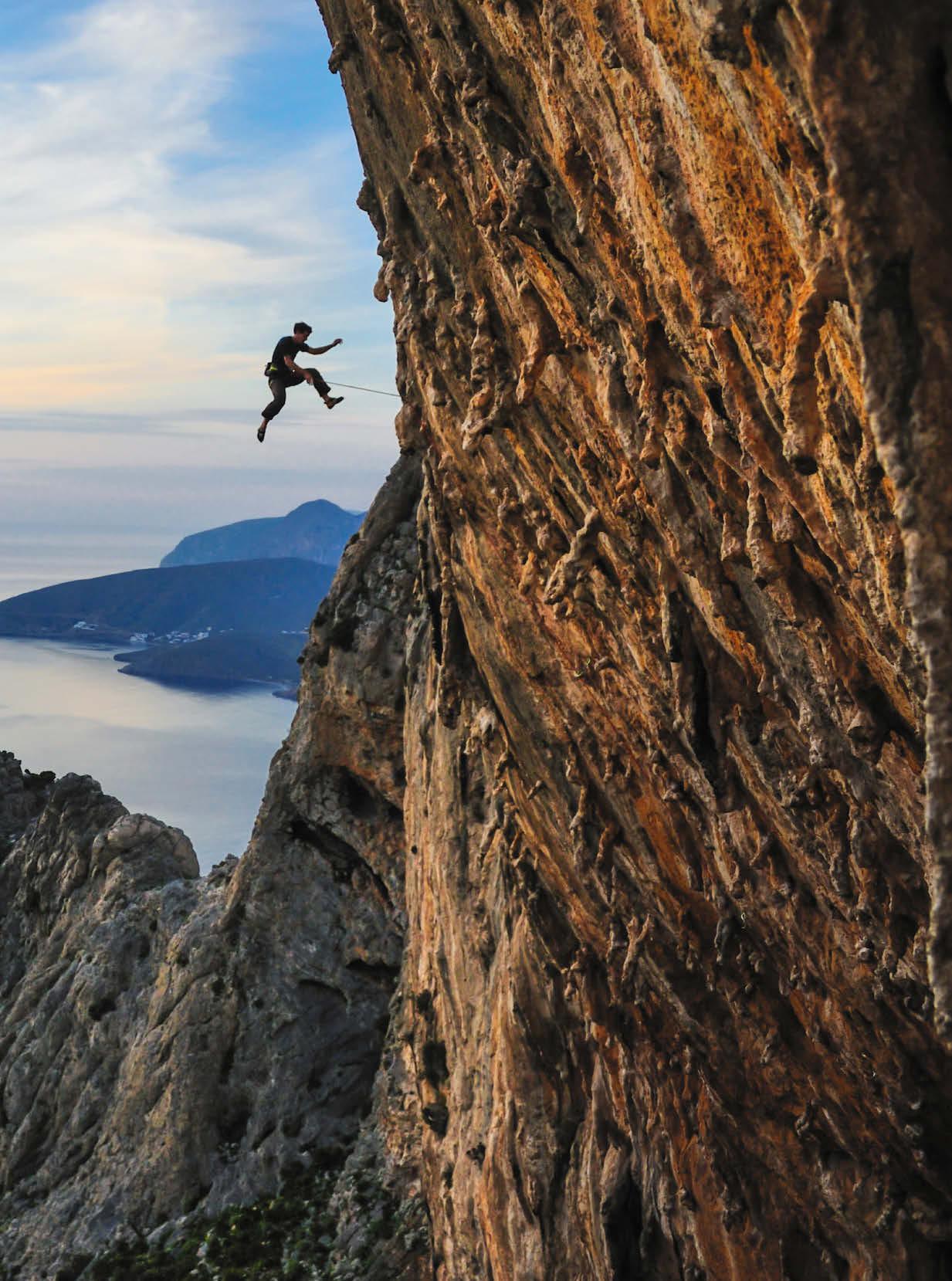 Keith Ladzinski
Keith Ladzinski
“For a great photo, you need to capture two things at the same time: the right moment and the right light,” says US photographer Keith Ladzinski, 47, of his craft. And over the years he’s spent following the climbing elite to the world’s most inaccessible spots – Ladzinski estimates he spends about 60 hours a year in trees, waiting for that right moment – it’s fair to say he’s mastered both. The lifelong skater and climber lives in New York, but grew up in the climbing mecca of Colorado. He now travels the globe for renowned clients including Apple, National Geographic and The New York Times, capturing incredible moments from the natural world, on subjects ranging from climate change to action sports. “Around 85 per cent of our efforts go on location scouting,” Ladzinski says. “We’ve often been on the road for more than 30 days before someone gets to climb. It’s crazy!”

Travel with the photographer at ladzinski.com
Rock hard
Arjan de Kock, South Africa. Sport climber, boulderer and action-sports junkie. Waterval Boven, South Africa
“It doesn’t get much harder for climbers than here in the northeast of South Africa. That applies both to the routes, which are often overhanging, and to the rock itself. It’s made of extremely hard quartzite, and it takes Arjan – and his shoulders especially – to the limit.”

Dave Graham, USA. Elite sport climber known for his nextlevel bouldering skills. Grampians National Park, Australia
“The Wheel of Life, one of the world’s toughest boulder passages, lies in Australia’s largest mountain range, the Great Dividing Range, in the southeast of the country. Climbers need more than 60 moves to conquer it. I was fascinated by how easy Dave made it look.”


Lunar
Emily Harrington, USA. Champion climber with a love of big mountains. Yangshuo, China
“These almost unreal limestone karst landscapes in southern China formed about 500 million years ago. They remind me of the Asian-inspired natural worlds in the Super Mario games. Here, we see Emily taking a short break on Moon Hill before continuing on her intrepid way.”
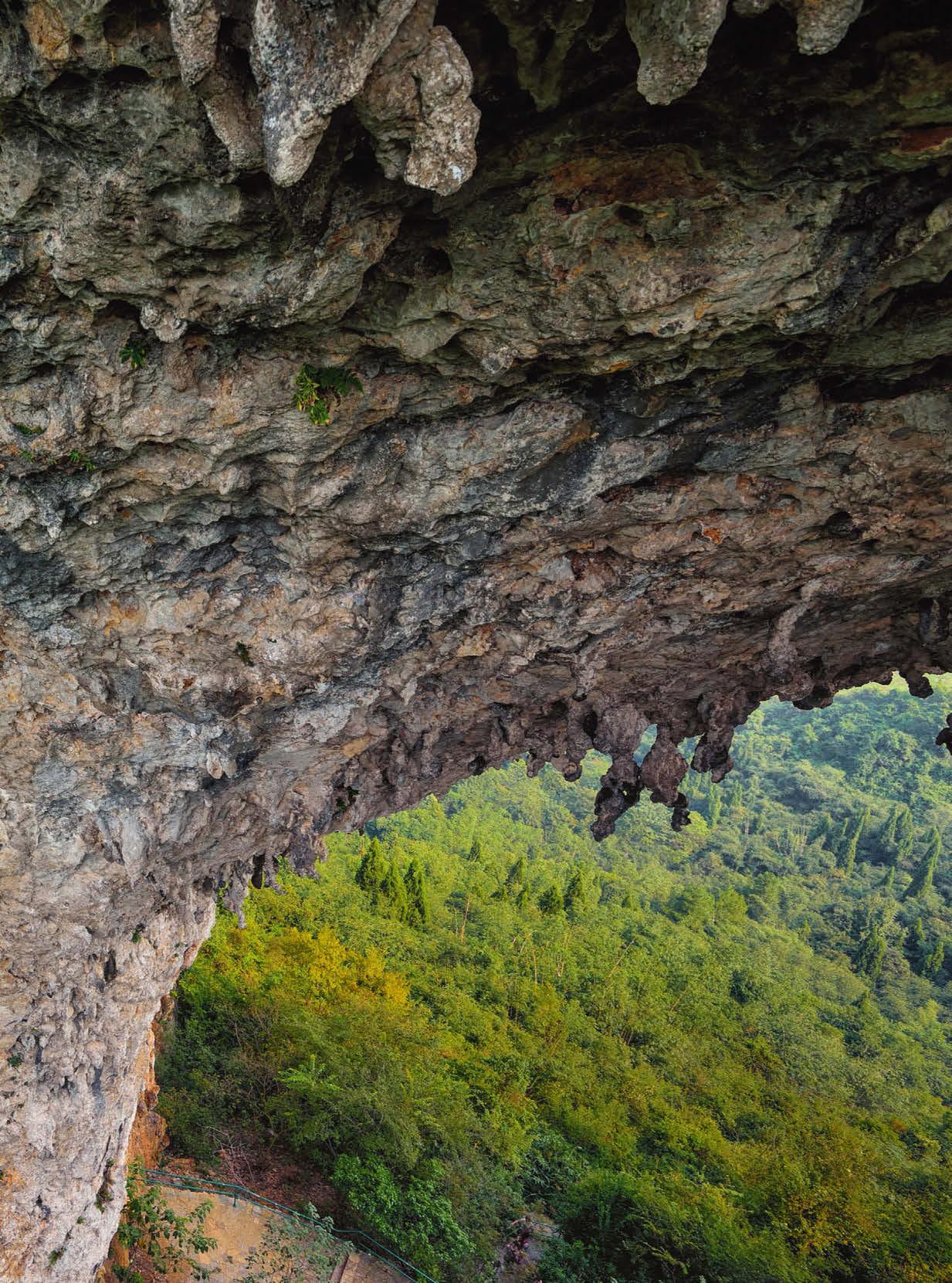

Mike Brumbaugh, USA. Trad climber and adventure entrepreneur.

Great Basin, Nevada, USA
“The Nevada desert is a treasure trove of sandstone climbing routes that no one has ever mastered. Here, Mike tries his hand at a first ascent of a rock face that’s as steep as it is immaculate.”
Caio Afeto, Brazil. Climber, extreme highliner, skydiver and wingsuit flyer.

Rio de Janeiro, Brazil
For our cover shot, Ladzinski captures the extreme highliner as he passes between two cliffs off the coast of Brazil, minutes before a storm engulfs the summit of the nearby Pedra da Gávea mountain. Afeto described this shot as “the best gift of my life”.
Hanging out
Joe Kinder, USA.
Professional climber. Mojave Desert, Utah, USA
“Climbing photography is about capturing key moments. This is Joe tackling a particularly finicky and therefore decisive point of the steep Visitor Q route high above the Mojave Desert in southwestern Utah. He’s climbing here for the very first time and seems literally stuck to the rock.”

Into the
Erik Leidecker, USA. Adventure climber and mountain guide.
“Iceland is a living, somewhat enchanted island. Professional climbers looking for a real thrill make their way down into the ice caves. Here, we see Erik setting off on a day trip into the deep blue underworld.”
 Keith Ladzinski
Keith Ladzinski
Jonathan Siegrist, USA.
One of the world’s most prolific and technical climbers.
Estes Park, Colorado, USA
“Sometimes a beam of light is enough to give a climbing route a completely new gloss. That day, the sun happened to hit the Grand Ol’ Opry in Estes Park exactly as Jonathan climbed the rock. The route takes him over uneven, slightly overhanging granite. A really major effort.”

Mike Libecki and Ethan Pringle, USA. Adventure climber; champion climber known for his diversity. Greenland
“Mike and Ethan didn’t get seasick on our 11-day boat trip through the pristine expanses of Greenland. But when our search for icebergs they could scale came to nothing, they were overcome by a rabid climbing fever. We provided them some relief by stopping off at this iceberg.”
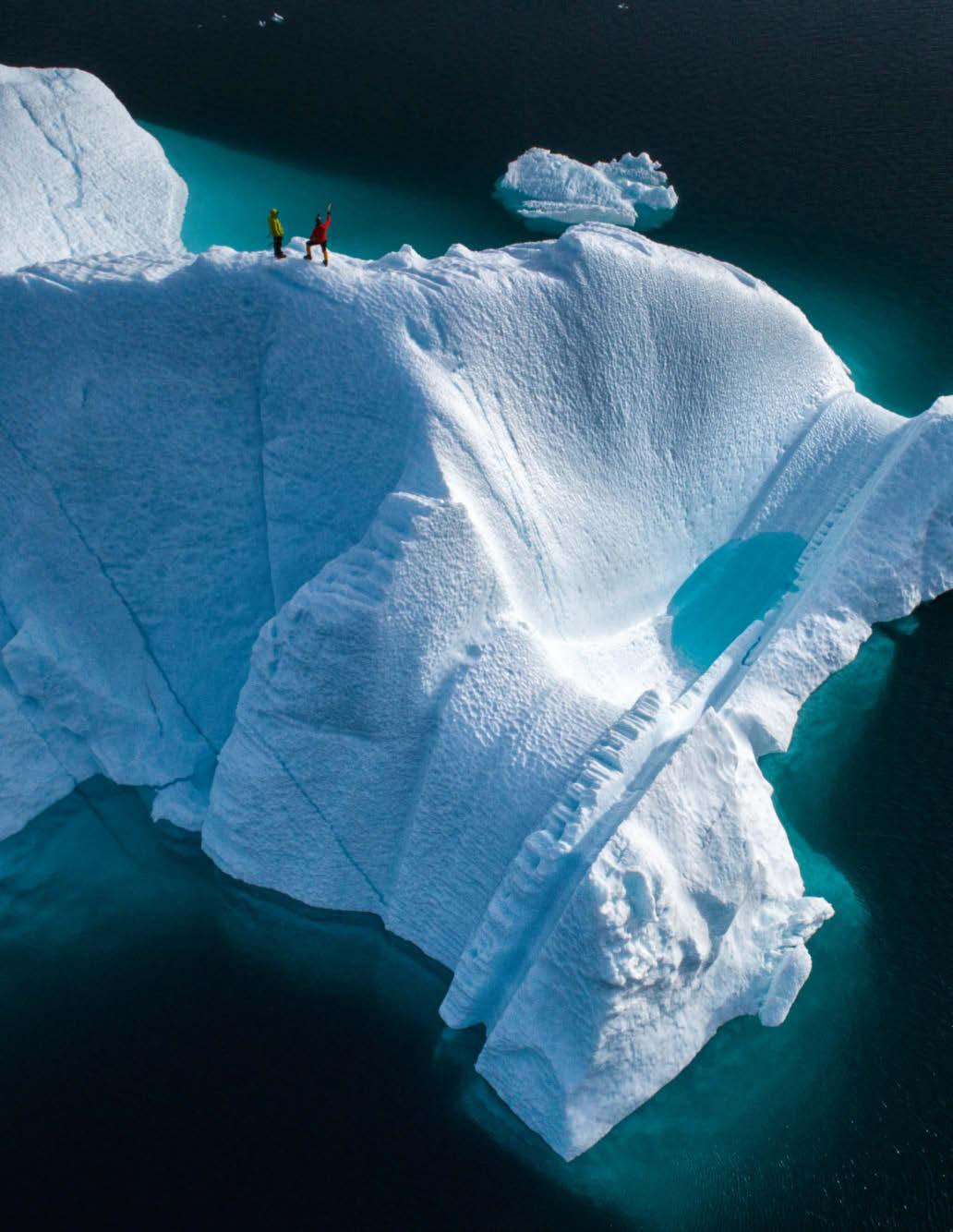
Crunch time: Claressa Shields and Savannah Marshall make boxing history at London’s O2 on October 15 last year

THE BIGGEST FIGHT IN WOMEN’S BOXING HAS BEEN RAGING FOR 300 YEARS: THE BATTLE FOR RECOGNITION OF THE SPORT ITSELF. NOW, IT’S BEATING THE MEN’S GAME, THANKS IN LARGE PART TO FOUR FIGHTERS FROM TWO HISTORIC BOUTS
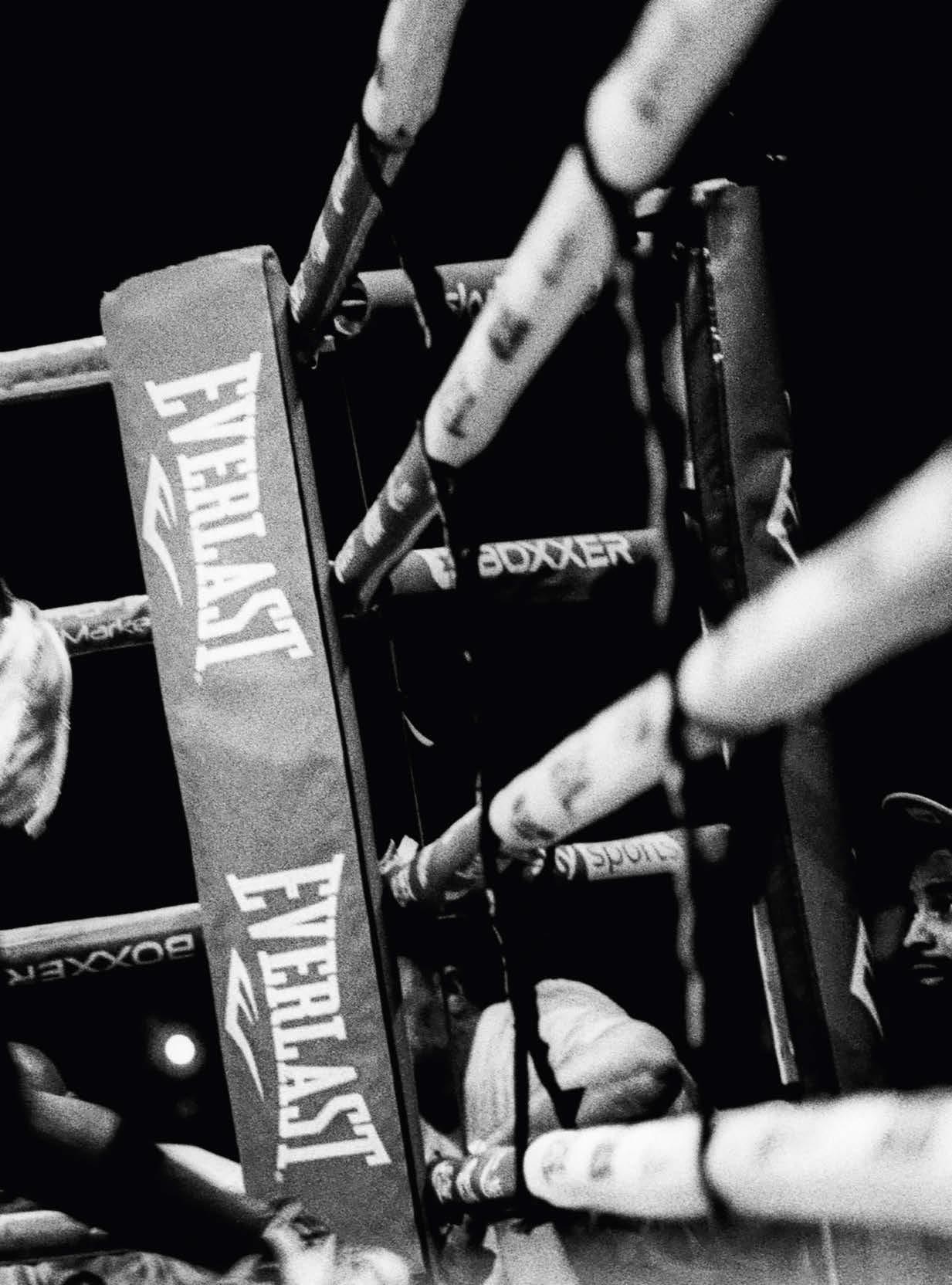 Words RICHARD EDWARDS
Words RICHARD EDWARDS
It’s a Friday afternoon in Bethnal Green, east London. It’s mid-October, but the mercury remains stuck in the late teens, no hint of a winter chill. At least not outside. By contrast, the atmosphere inside the Genesis Cinema is distinctly frosty. Due on stage for the weigh-in are Claressa Shields and Savannah Marshall – the former unbeaten in professional boxing, the latter the only fighter to ever taste victory over her, during their amateur days. For boxing fans it’s like the night before Christmas, as the pair prepare to face off outside the ring for a final time before the biggest fight in women’s boxing history.
Watching on, Nicola Adams, the first female boxer to become a double Olympic champion, and Johnny Nelson, a former world cruiserweight champion, talk excitedly while they wait for the American and her County Durham-born opponent to appear. Seats usually reserved for the latest blockbuster movie are full. There’s no popcorn in sight.
In the UK, anticipation for a fight already delayed by four weeks due to the death of the Queen has been heightened by the postponement of another last week: Chris Eubank Jr’s clash with Conor Benn at the O2, the venue where this fight will take place tomorrow. The buzz spreads well beyond the walls of this nondescript building in London’s East End. Crystina Poncher, a premier boxing commentator for ESPN in the US, explains that it’s not just the Shields vs Marshall match-up but the fact this is the first all-female card ever that’s creating waves.
“The build-up and excitement from fans, the media, is just as big [in the US] and it’s competing with two other cards on the same day,” says Poncher. Across the pond, the fight is already dwarfing the hype of former WBC heavyweight champion Deontay Wilder’s return against Robert Helenius in Brooklyn, a night that also includes Caleb Plant, the former IBF

Last year saw the first women’s boxing match to ever headline Madison Square Garden. Billed as “the biggest women’s fight of all time”, it was the mostwatched female bout in history… for just six months. Another fight was already set to take its crown
Heavy gains: Shields with her belts in Atlantic City in 2019. For the fight against Marshall, she risked five – WBA, WBC, IBF, WBF and The Ring – for a shot at WBO middleweight and the new Elizabethan Belt

A cut above: Marshall trains ahead of her fight with Shields. At the time, they had matching pro career stats: 12 wins, no defeats; (opposite) at the weigh-in

super-middleweight champion, on the undercard. “I’d say the women have pretty much stolen the show.”
Eventually, the two fighters appear. They follow Alycia Baumgardner and Mikaela Meyer, two fighters separated by similarly bad blood. Marshall, referred to as the ‘Silent Assassin’, smiles as she steps onto the scales. She weighs in at 11st 5lb 5oz (72kg).
From behind her, Muhammad Ali’s voice suddenly booms out, “The champ is here. The champ is here,” his words sampled on the Jadakiss song of the same name. A brooding Shields walks forth. She’s in the mood. It’s business time. After tipping the scales at an identical weight to her opponent, she prepares to carry her belts for a face-off with Marshall. It’s no easy task. In fact, it’s a three-person job.

That’s when the magnitude of Shields’s incredible achievements hit home. She’s the holder of 12 belts across three weight divisions. If Marshall is under any illusion that Shields will surrender a single one of them, the message is clear. In the pre-fight showreel, she stares down the camera. “Anyone who doubts me, that’s OK, you’ll be a fan soon enough. And Savannah Marshall? You just wrote a cheque your ass can’t cash.”
Anyone wondering whether this is part of the act only needs to see the glint in each boxer’s eyes. This shit is real. And if Marshall wants to take Shields’s belts from her, she’ll need two things. The first is courage. The second is a removal van.
Throughout the ages, boxing has been built on rivalries. From Sugar Ray Robinson and Jake LaMotta in the 1940s and early ’50s, to the triumvirate of Ali, Joe Frazier and George Foreman, right through to Mike Tyson, Evander Holyfield and Holyfield’s ear, the sport leans heavily on the enmity between those stepping into the ring, to create narratives, promote fights and put bums on seats.
The growth of the women’s game, although partially driven by the trash-talking that has helped build up the Marshall and Shields bout, has mainly been a result of the standards pioneered by the latter, along with a boxer who, not so long ago, was playing for the Irish national football team: Katie Taylor.
Taylor and Shields are very unlikely to ever meet each other in the ring – their weight difference makes any match-up too favourable for the latter. But like Shields, the 36-year-old Olympic champion (she won lightweight gold at London 2012), born in Bray near Dublin, is unbeaten in a professional fight. Since October 2017, when, less than a year after turning pro, she won the WBA lightweight belt by defeating Argentine Anahí Ester Sánchez, Taylor has emerged as one of the pre-eminent forces in global boxing.
Dubbed ‘the Bray Bomber’, she’s arguably Irish sport’s finest ever export, a fighter whose brilliance has caught the imagination of seasoned fight-goers across men’s and women’s boxing. As Matthew Macklin, former middleweight British and European champion and now one of Sky’s boxing experts, explains, “You only have to go to an Anthony Joshua fight, even a stacked card with several world title fights, and Katie Taylor steals the show pretty much every time. She’s the performance of the night.”
Few would argue with that assessment, least of all the string of boxers who have felt the full force of Taylor’s power during her 22-fight career. Among them is the Puerto Rican Amanda Serrano, another key figure in the sport’s rise, and a fighter who, alongside Taylor, made history in April 2022.
Every sport has its historic venues, synonymous with golden moments. For boxing, Madison Square Garden (MSG) in midtown Manhattan is one such location. From the moment Rocky Marciano walked into the venue in 1951 and forced Joe Louis back into retirement, right through to the Fight of the Century in March 1971 when Frazier erased the word ‘unbeaten’ from Ali’s biography, or Andy Ruiz Jr’s demolition job on Joshua in June 2019, MSG has played host to some of the sport’s most iconic battles.
ANYONE DOUBTING THE RIVALRY NEED ONLY SEE THE GLINT IN THEIR EYES
As recently as five years ago, any suggestion that two women would one day headline a card there would have been dismissed as fantasy; a non-starter in a testosterone-dominated world in which men have held sway across the venue’s 140-year history. This crop of female boxers, though, are cut from a different cloth. All are well aware not only of their extraordinary ability in the ring but how this affects their value outside it. So, when Serrano and Taylor’s original Manchester bout was knocked off
Women’s boxing
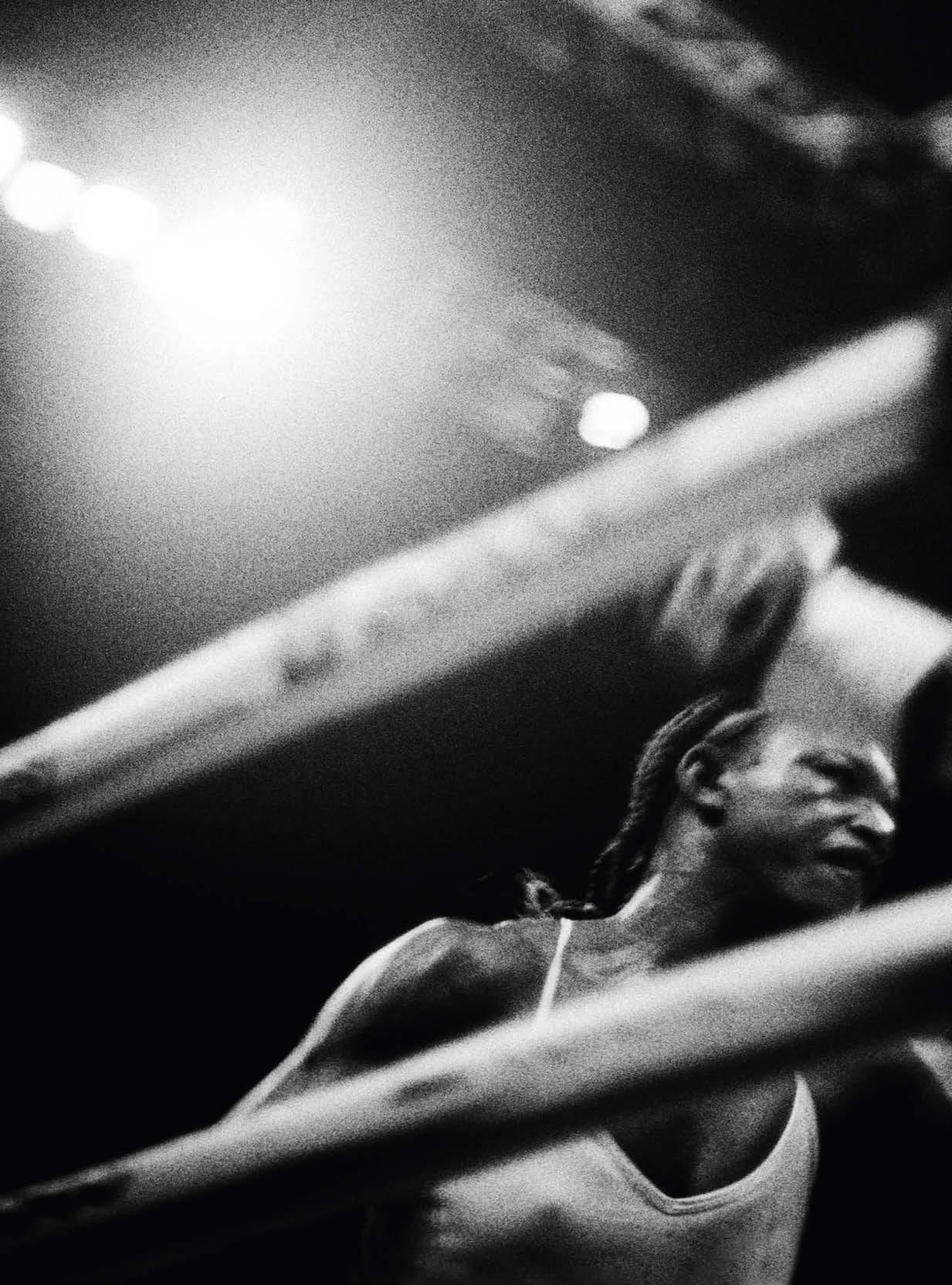
THE FINAL TWO-MINUTE ROUND PROVIDED MORE
DRAMA THAN SOME FIGHTS
PRODUCE ACROSS 12
Balance of power: Shields corners Marshall in the ring. The fight was a close but unanimous victory for Shields


“KATIE TAYLOR STEALS THE SHOW EVERY TIME. SHE’S THE PERFORMANCE OF THE NIGHT”
the calendar by the pandemic in May 2020, there was only one possible location in both fighters’ sights when the rematch was rescheduled.
Reports suggested Serrano was offered £300,000 for the 2020 match-up, but by the time promoters had reconvened it was clear that a fight pitting the number one (Taylor) and number two (Serrano) –the best pound-for-pound fighters in world boxing –against each other would be far more lucrative. MSG was an arena befitting their ambition. And boxing fans who greedily snapped up tickets clearly agreed. “You obviously know your worth when you’re capable of selling out arenas and stadiums,” Taylor said at the time. “We’re both in a position where we’re able to do it and not just sell out a stadium but sell out Madison Square Garden, which is very special.”
None of these figures, of course, would have been achievable without the promoters working alongside a unique generation of female boxing talent. YouTuber-turned-boxer Jake Paul signed Serrano to his company, Most Valuable Promotions, after responding to a tweet from the fighter in April 2021. Since then, he has supercharged her career and, alongside Eddie Hearn at Matchroom and Boxxer’s Ben Shalom, helped to both raise the profile of the sport, and the size of the purses on offer to those women putting their bodies on the line for global titles. Conor McGregor is also a highprofile fan of Katie Taylor and sent her a good-luck message before her MSG bout. “I hope it just puts [women boxers] on a different pedestal of respect and gets them paid better,” Paul said after signing Serrano, also a major MMA star. “Because they are the most underpaid. That’s what I’m looking to do.”
By the time Taylor and Serrano were the headline act at MSG – to global fanfare – a seven-figure payday was assured. The Bray Bomber, meanwhile, made it clear she wasn’t eyeing a temporary rise in purses for women’s boxing – she wanted to secure the sport’s long-term future. Hardly a surprising ambition given that when starting out she’d have to dress as a boy just to get inside the ring. “I feel like we’ve covered a lot of ground over the last few years in terms of the paycheque and purses, but we have a long way to go,” Taylor told CNN on the eve of the fight. “It’s not OK that myself and Amanda are just the ones getting the big paycheques. That has to carry over to other female fighters as well, and I hope that can happen.”
It would be easy to focus on the rewards these fighters are now receiving. But this journey can’t be distilled into pounds-and-pence, dollars-and-cents calculations. To understand how far women’s boxing has come, we must take a trip into London’s past.
At first glance, an event that took place in June 1722 would appear as relevant to modern women’s boxing as Adam and Eve are to the Apollo space programme. On the mean streets of Georgian Britain, though, Elizabeth Wilkinson was busy making a name for herself – as a bare-knuckle pugilist. And although the modes of communication
were slightly different back then, her challenge to another fighter by the name of Hannah Hayfield carried with it the same hint of menace.
“I, Elizabeth Wilkinson of Clerkenwell, having had some words with Hannah Hayfield, and requiring satisfaction, do invite her to meet me on the stage, and box me for three guineas, each woman holding half a crown in each hand, and the first woman that drops her money to lose the battle,” reads the statement from Wilkinson, published in The London Journal 300 years ago last summer.
Wilkinson may have been an early pacesetter for the women’s fight game, but the speed at which it evolved over the next three centuries wasn’t so much slow as utterly glacial, despite the best efforts of the likes of Barbara Butterick, the Yorkshireborn founder of the Women’s International Boxing Federation in 1989. Known as the ‘Mighty Atom of the Ring’, Butterick was a fearsome competitor, ending her career in 1960 with just one defeat in 32 bouts. Standing at four foot 11in (1.5m) and weighing just 98 pounds (44kg), she was a flyweight who packed a punch. But, despite Butterick’s best efforts both in the UK and the US – she toured extensively across the Atlantic – by the time she hung up her gloves, women’s boxing was no nearer to being accepted than when she’d first strapped them on.
Other attempts ended up being mocked by the establishment. A women-only boxing tournament organised by Sue Atkins in a pub – the Foresters Arms – in Tooting, London, in 1993 ended up not being covered in The Ring magazine but plastered across three pages in a soft-porn publication, an ambush that none of the fighters involved were remotely aware of. It wasn’t until August 1998 that the British Board of Boxing Control handed female boxers a licence to fight. And that only came about following a sex-discrimination case brought by Jane Couch – a boxer from Fleetwood, Lancashire who, for the next decade, would carry the torch for the sport, not just in the UK but around the globe. As the millennium dawned, however, the chance of million-dollar purses, sold-out nights at the O2 or MSG, and female fighters heading up pay-per-view cards on Sky within 20 years seemed about as likely as Wilkinson returning from the dead to reprise her rivalry with Stone Cold Hannah Hayfield.
“I had some very dark times in my life where I did want to give up, I did want to commit suicide,” said Shields after the fight last October. “[But] I stayed strong and didn’t let the doubters who questioned my greatness get to me. I didn’t let my childhood trauma get to me. I would just tell my younger self, ‘Keep pushing, it gets better, don’t give up.’”
Flint, a city roughly 90km northwest of Detroit, recently honoured Shields by renaming the street she grew up on. This is a welcome cause for celebration in a corner of Michigan that, according to 2021 census data, suffers some of the highest levels of deprivation in the US. The national rate of childhood

poverty is 16.9 per cent; in Flint, that figure rockets to 49.8 per cent. Some of the city’s residents will never find a way out; others will look at Shields as the living, breathing embodiment of the possible.
In an interview with the BBC at Rio 2016, shortly after becoming the first American in history to defend an Olympic boxing title – a second middleweight gold to add to the one from London 2012 – Shields pulled no punches on just how harsh her upbringing had been. “I didn’t start talking until I was five,” she said. “By then, my father had been in prison for three years for dealing drugs. I wouldn’t meet him again for another four. I’m not going to say my mum didn’t care for us, but she left us to fend for ourselves. She abused alcohol and didn’t know how to control it. There were times my little sister and I would walk around looking for Mum for days on end. I’d have to go out and get food. If there were two packs of ramen noodles, my little sister ate one, my little brother ate one, and I didn’t eat. We’d sleep on the couch or floor, and more than likely my sister or my brother was on the couch, so I’d be on the floor.”
Shields revealed how she was raped “every day for about six months by a person known to the family”, and how a speech impediment left her unable to articulate her horrific experiences. Boxing was a way out. Since her first professional fight, in November 2016, aged 21, against Franchon Crews
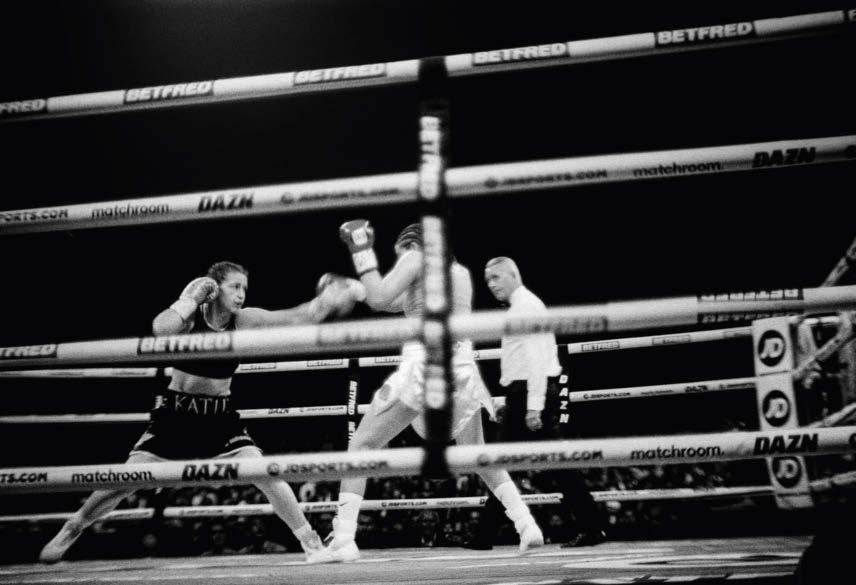
in the super middleweight division, few fighters in history – men or women – have turned so many negatives into one giant positive so successfully.

In many ways, Shields and Taylor are worlds apart. This is exemplified by their pre-match routines backstage: Shields and her crew burst with energy, rap music blaring out, while Taylor sits introspectively, listening to calming music on her earpods. But one factor that unites them both, beyond their unsurpassed skills in the ring, is their Olympic success and the springboard that the Games provided them as they navigated their path from the amateur ranks to the top of the sport. In the case of Taylor, she was one of the fighters directly responsible for the International Olympic Committee’s historic decision to include the sport, following a meeting in Berlin back in 2009. The die, though, had been cast two years previously.
“I got in front of the whole Olympic Committee in Chicago and fought an exhibition bout at the men’s World Championships,” recalled Taylor in 2019. “A few days before the actual fight, I had a meeting with the committee and they told me that this fight was going to be responsible for whether [women’s] boxing was going to be in the Olympics or not.
“I was shaking after that meeting. I knew that this was going to be more than just a fight. All the weight was on our shoulders in that fight.”
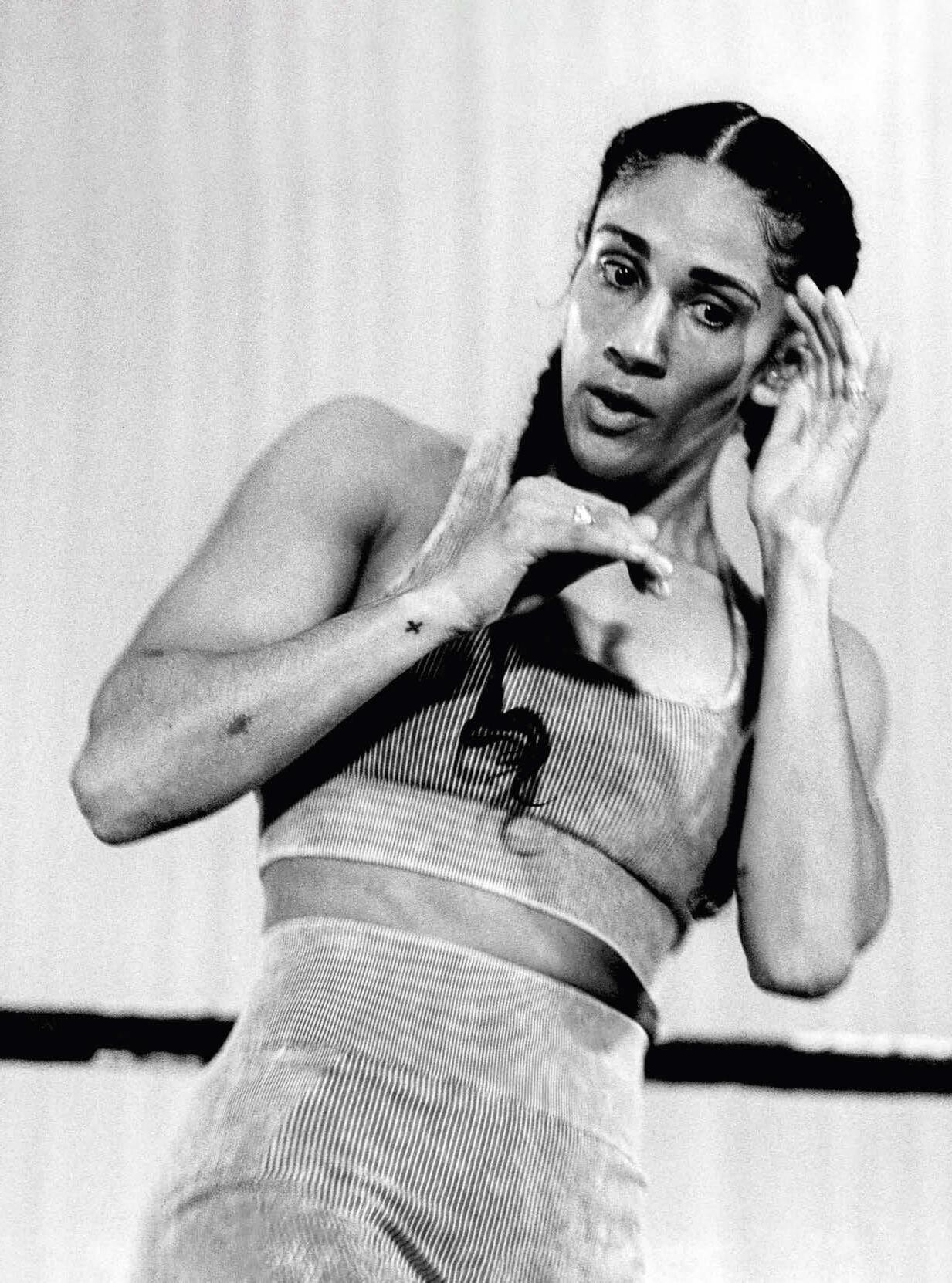 Hone zone: Serrano trains before a fight. Her record: 46 fights, 43 wins, 30 of them KOs
Hone zone: Serrano trains before a fight. Her record: 46 fights, 43 wins, 30 of them KOs
A SERRANO/TAYLOR REMATCH COULD DWARF EVERYTHING THAT’S GONE BEFORE

 Roar emotion: Shields celebrates in triumph as the results of the fight against Marshall are called out
Roar emotion: Shields celebrates in triumph as the results of the fight against Marshall are called out
All those invested in women’s boxing needn’t have worried – as evidenced by the elevation of the sport in subsequent years, the IOC couldn’t have put it in safer hands. And the competition at London 2012, although limited to just three weight divisions – fly, light and middleweight – didn’t only provide a focal point for female boxers around the world, it lit a spark that has been burning ever since.
“They ignited a fire in me to have a dream to go to the Olympics,” says Caroline Dubois, a member of the UK Olympic team at Tokyo 2020, and a fighter on the undercard for the Shields vs Marshall fight. She was joined on that all-female platform by Lauren Price, a gold-medallist in Tokyo, and Karriss Artingstall, Price’s partner and another medal-winner at the same Games. Both aged 28, Price and Artingstall now seek to emulate the success of Taylor, Shields, Serrano and Marshall in the professional game. Strip away the hype, the purses, the media coverage and the superstardom attained by all four and their most lasting achievement isn’t measured in belts but rather the opportunities they have created for others to follow.
“The O. In the men’s fight game, it’s all about The O,” says Alex Beer, the photographer who has spent the past four years following the world’s leading female boxers around the globe. His raw black-and-white portraits vividly depict the progress made by both the sport and its athletes during a period that has seen the popularity of women’s boxing explode.
The O is the unbeaten record and the need to preserve it. In men’s boxing, this often means dodging opponents, evading challengers, and the best not always meeting the best. Sometimes this avoidance goes on for years, as anyone who has followed the careers of Tyson Fury and Anthony Joshua will attest. “In women’s boxing, that just doesn’t exist,” says Beer. “They’ll take on whoever they need to – we saw that last year.”
Both Taylor and Shields put their reputations and belts on the line in 2022, and both went into the New Year with their O still intact following two stunning fights on era-defining nights on both sides of the pond.
Back in April 2022, Serrano had Taylor on the ropes. In every sense. In the fifth round, a right upper-cut and a left-hook had Taylor bloodied and teetering. By the time the bell rang, she was hanging on to an unbeaten record that had never been under such threat. Ultimately, though, as all great champions do, Taylor found a way. One judge scored the fight 96-94 in Serrano’s favour; the other two made it 96-93 and 97-93 in the opposite direction.

The newspaper The Guardian called it as a 95-95 draw, an indication of just how close this bout was.
It was a similarly tough task for Shields at the O2 last October, with her English challenger providing stubborn and often brutal resistance in front of more than 20,000 fans, not to mention the biggest audience ever recorded for an all-female event on Sky Sports. More than two million people tuned in to watch a slugfest that some seasoned boxing fans labelled the fight of the year. The final two-minute round provided more drama than some fights produce across 12. Wild hooks from both fighters rained in as a spellbound crowd watched on.
The toast of Flint won a unanimous points decision, almost but not quite managing to silence a raucous London crowd. Bruised and battered, Marshall gave her view of a fight for the ages: “I’m disappointed I came up short, but if it has pushed female boxing I’ll be happy. I’m very proud – there were times when I was struggling to even get on cards. Next thing, I’m headlining the O2.”
Shields, meanwhile, celebrated her victory in a style reminiscent of her win at London 2012, jumping and screaming as the verdicts were read out. “I had to work so hard for a very long time, and nobody has given me credit,” she exclaimed. “It’s a special moment not just for me but for women’s boxing.”
Later, she reflects on her achievement to The Red Bulletin. “Headlining an all-female card at the O2 with a crowd of 20,000 fans and [two] million viewers was unthinkable at the beginning of my career,” Shields says. “But I knew the impossible was possible. I’m proud of the history I’ve made, and the strides toward parity for women. We’re still fighting for equal pay, but we’ve definitely raised the bar.”
So, what’s next? Well, if the events at the O2 and MSG were big, the return fight between Taylor and Serrano – scheduled for May 20 on Taylor’s home turf of Dublin – could dwarf them both. A rematch of the Shields and Marshall fight is also on the cards, likely this summer in the US – a bout that will have sponsors and major boxing networks falling over themselves to be involved.
Alongside her ambitions inside the ring, Shields has a more prosaic aim, one shaped by her own turbulent and often violent upbringing. “In my personal life, I just want to focus on my niece and nephews, make sure they pass their grades in school and have a better childhood than I had,” she says. “I’m also planning for my marriage in 2024. The big personal goal after that is having my own kids.”
She pauses, and the Claressa who strode forth at the weigh-in returns. It’s business time once again. “There are more boxing records I’d like to achieve – undisputed in another weight division, world champion in a fourth division – and if someone comes along who people think is better or can KO me, I’ll be ready to prove them all wrong again.”
Thanks to JJ O’ Regan and Matty Lawless at Boxxer and Ross Garritty at Matchroom for their assistance in gaining access to the fights
After propelling New Orleans’s bounce music into the mainstream more than a decade ago, charismatic rapper and reality star BIG FREEDIA is ready to spread her sound around the world
 Diva forever: Big Freedia, photographed for The Red Bulletin in New Orleans last December
Diva forever: Big Freedia, photographed for The Red Bulletin in New Orleans last December
Shining bright: Freedia in sparkling form; (opposite) on stage with her dancers at live music venue Tipitina’s in New Orleans

“I was always the one who was loud and out at school”
It’s late on a Tuesday morning in December, and deep belly laughs are echoing off the walls of Tipitina’s, a historic music venue in New Orleans’s Uptown district. The ceiling beams of the performance space are plastered with vintage poster ads for famed artists including Irma Thomas, Fela Kuti and Taj Mahal, but just past the dancefloor there’s a side corridor that leads upstairs to the green room where another music legend is getting ready.

The resounding cackles of anointed bounce-music star and LGBTQ+ icon Big Freedia stand out from the others. Surrounded by her close-knit team, the ‘Queen Diva’ is sitting pretty on a black leather couch as she admires herself in the mirror prior to a quick on-camera interview. At 44, Freedia is confident but
also demure, flaunting soft glam, fanlike eyelashes, and crystals that dazzle everywhere from her earrings to the cropped seams of her top. Her sheeny, jet-black hair is slicked up into a highteased ponytail, making her appear even taller than her six-foot-two [188cm] frame.
“Yes, honey, shine bright like a diamond,” Freedia playfully sings in response to a compliment on her shimmering look.
For more than 20 years, Freedia has been working tirelessly at her craft while taking bounce music around the globe. She’s released multiple EPs, an album, a book (2015’s Big Freedia: God Save the Queen Diva!), led six successful seasons of her US reality show (Big Freedia Bounces Back), started filming a new spin-off series (Big Freedia Means Business), and is now working on a new album. In the last five years, she’s been tapped for collaborations and samples by artists such as Drake, Lizzo and Beyoncé on more than one occasion. And most recently she received long-overdue acknowledgment from the Grammys with a 2023 Album of the Year
nomination for her work as a songwriter on Beyoncé’s Renaissance. “I’m forever grateful to come full circle with it all, to have a nomination and finally get the credit that I’m on a song as a writer,” Freedia says. “I get to see something for all my hard work. I don’t need the validation, though. I’ve been working for a long time.”
Born out of New Orleans’s housing projects in the late 1980s, bounce is the manifestation of the soul, nerve and vibrancy of the city. The hip-hop subgenre combines upbeat rhythms with punchy basslines and vocal repetition that make it impossible not to bounce your bottom while listening. Performing everywhere from small sweaty clubs to big concert venues, Freedia and her trusted crew of dancers have been all gas, no brakes in their mission to get crowds to move their bodies. “Commanding asses across the world” is what she calls it.
Freedia is firmly in control when she’s on the mic. Her ability to call a tune was nurtured during the years she devoted to
was around there like, ‘Girl, y’all ain’t bothering me. I’m running things.’”
singing with the acclaimed Gospel Soul Children of New Orleans, and as assistant director of her church choir. “Those were my early days of finding myself,” she says. “The church was my safe haven. My godmother Georgia, who was the choir director at my church home, opened her arms really wide and accepted me.”
“I was a heavy-set choirboy from New Orleans,” she says of her childhood. Long before she created a sanctuary through bounce, Freedia was known as Freddie. The church was a refuge and a chance to escape the hood where Freddie grew up. Her hairdresser mother and truck-driver father did their best to provide a good life for Freddie and her brother and sisters. Then, just before Freddie entered ninth grade, her parents’ hard work paid off and the family moved into a house in a better neighbourhood, where she was a budding student at Walter L Cohen High School in Uptown. “I was always the one who was loud and out at school – everybody knows who Big Freddie is,” she says, laughing. “When I’d come down the hallways, I’d be hitting choir notes. Most people loved it, some people hated it. But it was just my unique calling.”
Freedia understood her gifts at an early age and didn’t shrink to conform. She kept an open mind and always tried to give people chances – not the easiest disposition to have growing up as a young, Black, queer person in the Deep South. “Being Black and gay at that time was not so accepted,” Freedia says. “It was kind of hush-hush, and your family probably was embarrassed about having a gay person in the family.”
Before finding her confidence in high school, 12-year-old Freddie came out to her mother, who instantly protected her and allowed her to be her truest self. That support ultimately helped her flourish. “I was scared and I was timid, especially in elementary and middle school, because I was finding myself,” she says. “But in high school I was the choir director, so I had keys to the auditorium, and I was this queen who
The day after the photoshoot at Tipitina’s, a deadly tornado is brewing over New Orleans. As The Red Bulletin approaches Freedia’s house for our interview, the clouds begin to darken, and the wind is whipping trees and hurling leaves at the ground. Freedia is standing on the porch of her split-level home, no longer in photoshoot glam but dressed in a comfortable purple housecoat and matching silk bonnet. She’s finishing up a cigarette while telling a beautiful, black, three-legged doodle named Yoncé to get in the house. Off the stage and out of the spotlight, Freedia is tranquil and laid-back. Inside her cosy abode and safe from the storm, hand-painted portraits of Freedia are placed all around. The dining room next to the entryway is adorned with white furniture and elaborate place settings that look too perfect to be used for meals. For our chat, we sit in the living room, on a mustard-coloured velvet couch that rests against a matching velvet and corduroy wall, beneath a neon sign that reads ‘Big Diva Energy’.
Freedia’s strong work-ethic has kept her on a rigorous schedule for most of her music career. “From plane to plane, hotel to hotel, city to city, state to state, and overseas, it’s quite a load. Cooking things. Sponsorships I have to do promos for. It’s a variety of things, and it keeps me all over the place.” To have an international impact, Freedia travels everywhere. Bounce is frequently sampled in charttopping hits, but it’s still not recognised as mainstream on its own. Even though Freedia has been performing for 20 years, there are still more ears to reach and stages to dominate, so she’s always had to wear multiple crowns.
Before she began taking music more seriously in her early twenties, Freedia was a college student at the University of Louisiana, studying nursing, and had a side job decorating events for her mother’s social club – the Queen Divas – as well as other clients. But a pivotal performance at a block party with her best friend and bounce pioneer Katey Red created more opportunities.
“We used to play in the projects,” Freedia says of her early days with Katey Red. “We used to beat on electric boxes, and we’d make a beat and start saying any kind of thing. When Katey started in ’98,
me and my best friend Eddie would go to the studio with her, go to her gigs, dance on stage, and I started backgrounding for her. And then one day they told me to get on the mic and that was my first actual performance at a block party, hyping [it] up. When I started, people were like, ‘You heard what she said?’”
After that performance, word spread around New Orleans, and Freedia picked up more bookings for block parties. It began purely as something fun to do, and a way to make a quick $50-100 per gig. Two years later, in 2000, local record label Money Rules Entertainment took notice, helped Freedia land her first club gig, and showed her the ins and outs of the industry. A year after that, and with a growing following in New Orleans, she released her first song, Uh Huh, Oh Yeah
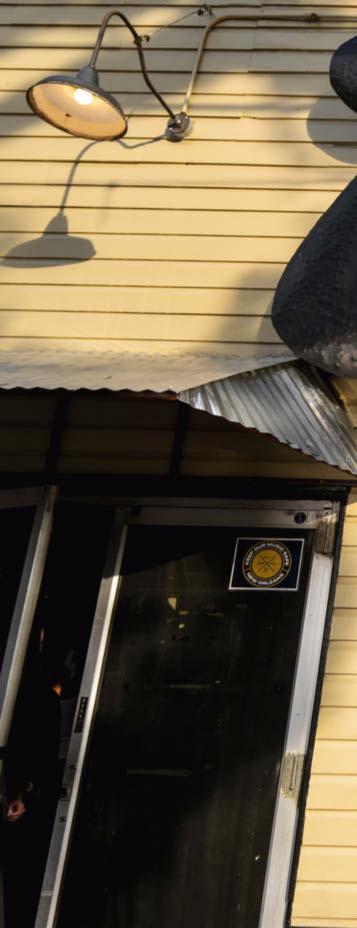
“The church was my safe haven. My godmother, who was choir director, opened her arms wide to me”
Her face lights up as she sings a few bars from the tune: “These hoes, they mad. Your boy, I had. I made… my cash.” “The girls loved it – it was so messy!” she laughs. The girls indeed loved it, as did rap superstar Drake many years later –so much so that he sampled it on his 2018 viral hit Nice for What. Freedia wasn’t invited to appear in the video for the song, however, so when Drake came to New Orleans to record the video for another bounce-influenced single, In My Feelings, Freedia reached out to the
rapper to be included, which she was. In an interview with TMZ, she called it a step in the right direction: “I think that other artists out there should feel the same way – that no matter what your background is, no matter if you’re a gay artist, we can be able to be there just as anyone else.”
Part of what makes Freedia so special is that the music she recorded in the early 2000s is evergreen. Ahead of her time, or right on time, she’s always had her finger on the pulse of what bounce would become to the world beyond New Orleans. In 2005, she fled to Houston when Hurricane Katrina forced her and thousands of others to evacuate. When Freedia returned, she started a party called FEMA Fridays at Caesar’s, the first
nightclub to reopen in New Orleans, and never looked back. She told herself she was done with juggling side jobs, working a nine-to-five and performing five shows a night. Music was going to be her “only child”, just as it had become an extension of her truest self.
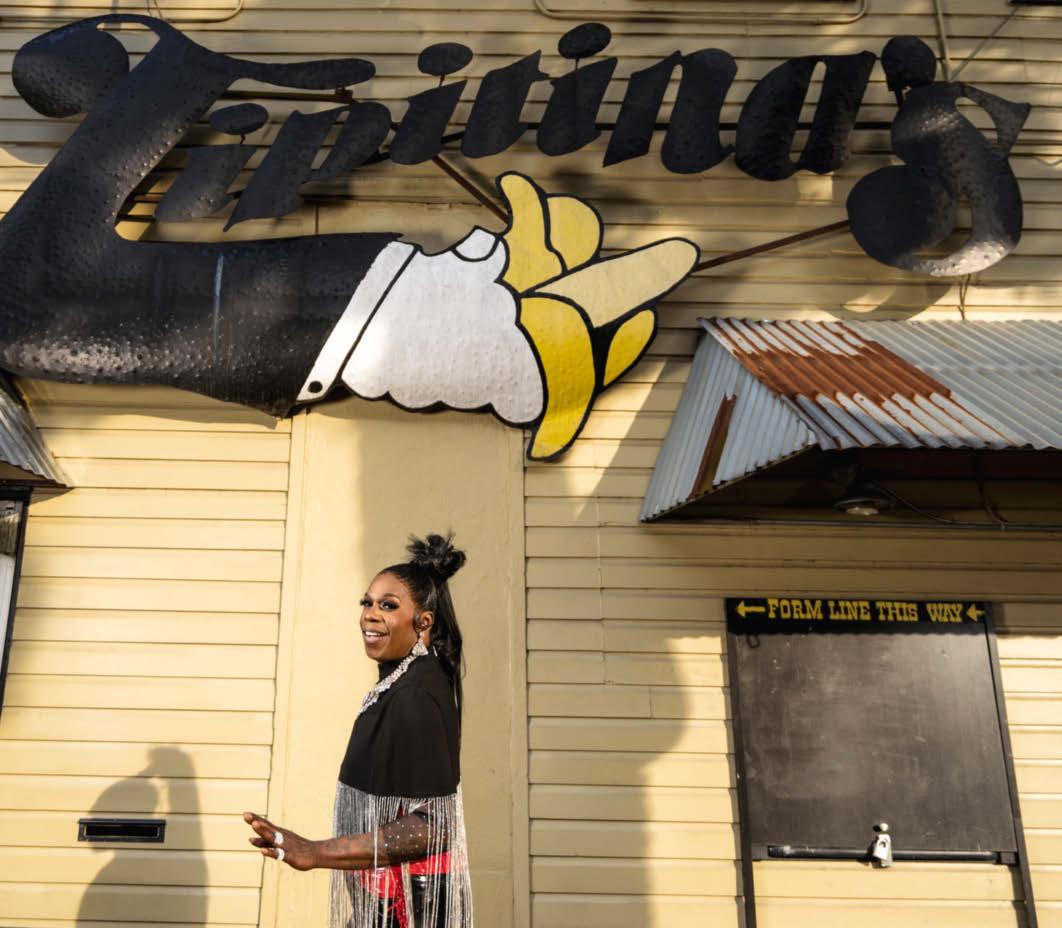
“We were displaced all over the world [after Katrina] and people were asking about the sound,” she says. “A guy called me and said, ‘Come to Houston. Everybody keeps saying, get Big Freedia.’ When he brought me to the club, I opened my mouth and it was like the whole choir in heaven started singing behind me. It was unbelievable. It was then that I knew I had something special.”
By 2010, Freedia had ventured out of the South to perform in New York City and LA, and then tastemaker publications
“Being Black and gay in the Deep South was not always so accepted”
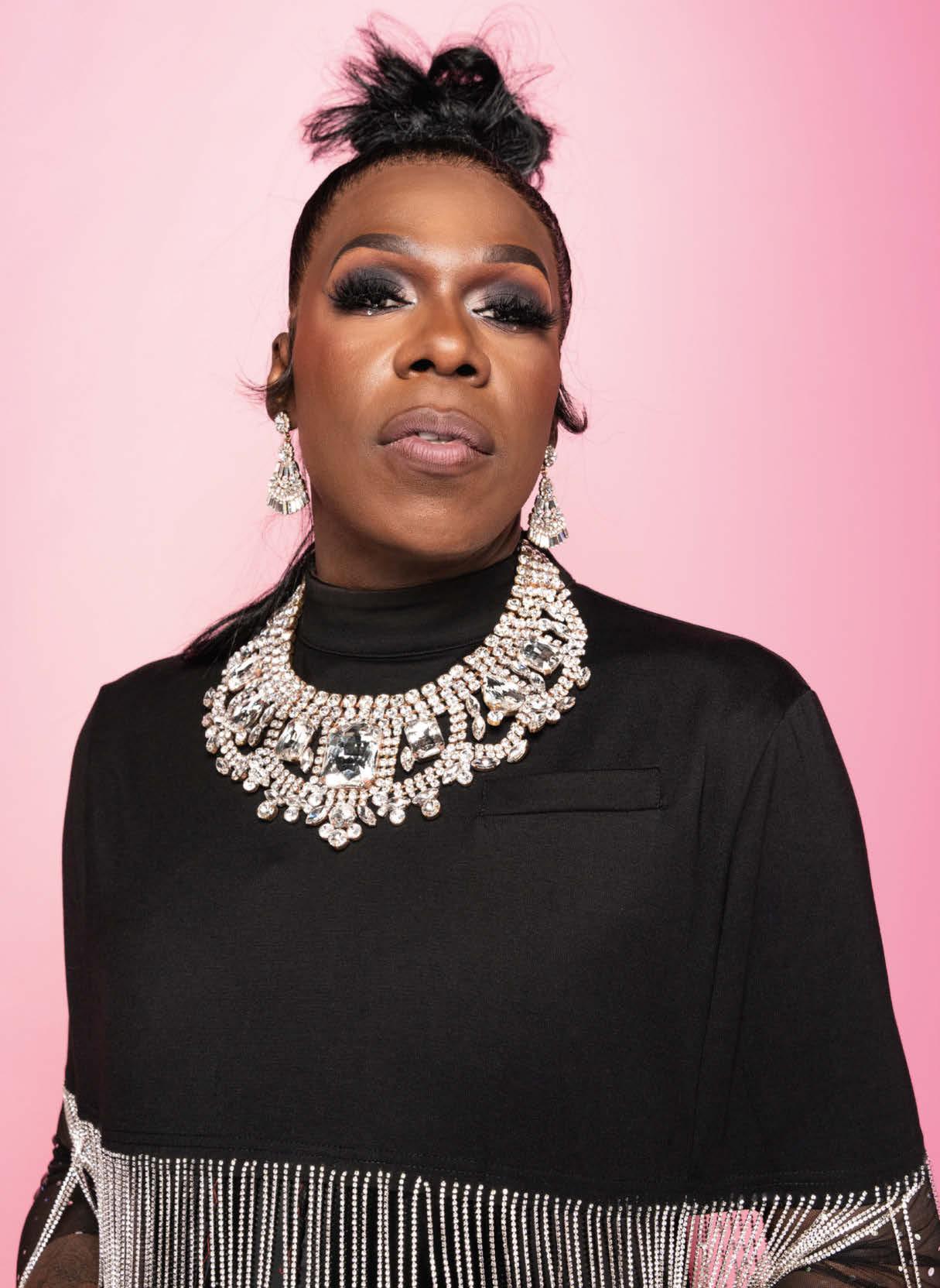
“I try to enlighten people’s spirits with my music”
started writing about her. When she was recognised in New Orleans by two white joggers who’d read an article about her in The New York Times, she knew bounce had travelled outside of her community and would change her life for ever.
Before Top 40 hits and white audiences became familiar with bounce, Freedia says, the foundations of the genre sprung from pioneers such as DJ Jubilee, Ms Tee, Cheeky Blakk and DJ Jimi, whose sound was rawer. “Back then, it used to be rough and raunchy. It was gangstas rapping bounce music, and they were talking about each other on songs. When Katey and other queens started jumping in, it went in another direction because we were able to open up another lane.”
When The New York Times wrote about Freedia in 2010, bounce artists were primarily straight Black men. After the high-profile article, which recognised queer artists for their contributions to the subgenre, Freedia says the straight performers started to “back up a bit”. But while the attention pushed Freedia’s community forward, she didn’t like the divisive take on their contributions. “I had to start telling them we don’t separate it here [in New Orleans]. It’s just bounce music, and I happen to be a gay artist. You got gay people who do it, straight people who do it, girls, guys…” Ultimately, the residual outcome was a shift that left Freedia and other LGBTQ+ artists at the helm.
When Freedia tells me about the two white guys who recognised her on the street, it’s impossible not to think about the mostly white audiences who buy tickets to her shows. It signifies her crossover appeal and recognition, which means more exposure and global popularity for bounce. But with that growth comes a co-opting of certain elements – twerking, to be specific. In 2013, with the help of Miley Cyrus, it was as if white women suddenly discovered the moves and then attempted to do them in bars and clubs and on social platforms, even monetising them through dance classes. Did Freedia ever feel protective of the culture during that time? “I’d be upset about it, but then I told myself, ‘You’re setting a foundation here, teaching people all around the world about the sound and the culture,’” she says. “People teaching twerking classes, that’s not harming me. But if a big artist came and took my sound and put it on their
song and they’re trying to get the credit for it, I feel like, ‘No, I been did that. I been doing this.’ But now I’m going down in history. It don’t matter what they do. And if I have to speak about something or a certain situation, I will. They just need to pay homage to the people who have set the foundation – the pioneers who have created this sound and the culture of New Orleans.”
This is why being included in a music video, listed in the song credits and finally being nominated for Grammys means so much. “I think things are changing,” Freedia says. “Doors are opening even wider, and they’re seeing that the culture of bounce is definitely a big staple in the music game.”
Even if Freedia doesn’t feel like she needs the endorsements, it’s what she’s owed. There have been times when she admits she felt like giving up because she has had to work so much harder, being a gay artist who presents outside the confines of the gender binary in an industry that’s taken way too long to evolve. To remedy this, she’s set boundaries, continued to advocate for herself and her community, raised her price and pushed forward.
Last year, Freedia started working on her new album, Central City, due for release in 2024. The project is almost complete, thanks to a mega recording camp where Freedia and a fire team of writers and producers worked together to create droves of tracks. It’s a doubledisc record that nods to her debut from 20 years ago. “This is like taking it back to the roots and elevating it with a few different new sounds,” she explains excitedly. “It still has that raunchy old Freedia that everybody’s used to. It’s my dance/disco album where I’m making the clubs dance down. That music you can play at festivals. The party is jumping.”
Until then, she’s filming her new reality show, Big Freedia Means Business, which is set to air in the US this summer and in the UK on WOW Presents Plus later in the year. The series will provide a look at how Freedia runs her empire, but, more specifically, she wants to
give young viewers an insight into things like finding new business ventures, conducting themselves in meetings, starting LLCs and paying taxes. Reality TV allows the audience to see Freedia as she is right now, talking about her life in her coordinated living room while barefaced in slippers and loungewear.
The real Freedia is down-to-earth, caring, calm, hospitable and hilarious. “You get to see me in my everyday life,” Freedia says. “I’m very humble when I’m not on stage. I’m not loud, and I don’t want to be seen and all that. I’m the one who’s hiding in the background, trying to feed everybody.”
While she’s grateful for her growing fame, adjusting to it can be a lot sometimes. Freedia still sees herself as “that hood bitch” who wants to keep normality in her life. These days, when she steps out in public, everybody wants to hear her signature phrase, “You alread-y knooooooow!”, delivered in her singsong style. “Girl, it takes power and energy to do that every time I see a person,” she says with a laugh. “I’m not in the grocery store trying to say that. I’m trying to get my groceries.”
As the storm picks up, Freedia is debating a trip to the supermarket so she can cook dinner. It’s getting scary outside; phones and Freedia’s home alarm system are blasting alerts, urging people to find shelter from the approaching tornado. Freedia – who survived Hurricane Katrina by cutting a hole through her roof, calling a local radio station for help and being rescued by a boat – remains serene as the raindrops crash down, lightning strikes, and objects in the backyard begin to take flight.
She flickers the porch lights to flag down The Red Bulletin’s taxi in front of her house, and says, “If you get stuck at the airport, let me know. I’ll come get you.” Freedia cares – a lot. And it’s more than just the formalities of Southern hospitality. It’s no wonder that masses of people across the world assemble to be touched by her glow.
In their bare form, bounce rhythms stand out on their own, but when Freedia adds her charm and wit, those sounds transform into something extraordinary. “I love my music, I love what I do,” she says. “I take it and try to enlighten people’s spirits. You might not be able to come to New Orleans, but I’m going to bring New Orleans to you.” bigfreedia.com
“My new album takes bounce back to its roots and elevates it with new sounds”
It’s a country that has produced more motorsports champions per capita than any other. But among these greats, a new legend has risen. Why is Finland the kingdom of racing drivers, and who the hell is KALLE ROVANPERÄ?

Icy determination: WRC champion Kalle Rovanperä takes his title-winning Toyota GR Yaris Rally1 Hybrid for a spin on closed roads near Korpilahti, Finland, last December

To the uninitiated, these sonorous Finnish words might seem like the names of local delicacies, fine liquors or invigorating sauna oils, but for anyone who grew up in central Finland they mean only one thing: the special stages of the Suomen MM-ralli, aka Rally Finland, the fastest event on the World Rally Championship calendar, and a national institution that has been held without interruption since 1951.
The world’s greatest rally drivers barrel along these smooth, winding gravel roads, past lakes, birch forests and picturesque meadows, at speeds averaging more than 125kph, and whenever all four wheels leave the ground for more than 50m at a time,
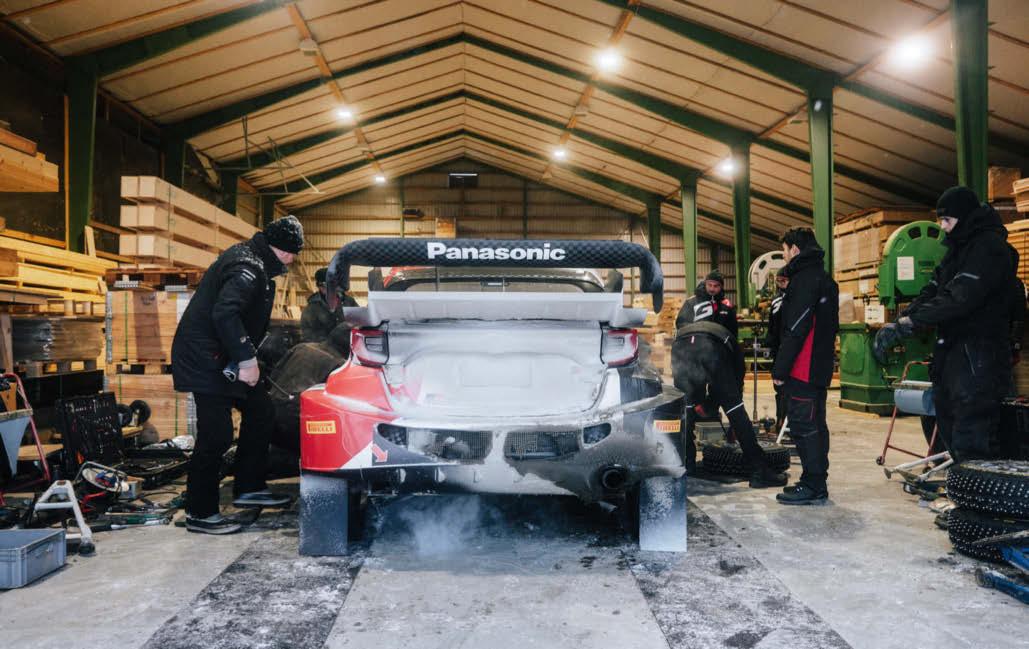
the whole country jumps to its feet and cheers on its heroes. For most of its history, challengers from beyond the Nordic region stood no chance in this rally. Indeed, it took almost 40 years for one to win in the land of a thousand lakes. If the Finns had had their way, it would never have happened at all.
First, in 1990, Spanish rally legend Carlos Sainz Sr snatched victory in the event – named the 1000 Lakes Rally at that time – on his way to his first WRC title. Two years later, France’s Didier Auriol added his name to the legend. But it was two French Sébastiens – Loeb and Ogier – who really shook this most of Finnish institutions to its foundations, winning it four times between them from 2008 to 2013. It was a national tragedy in the far north.
Around this time, there was a boy in the forests near Jyväskylä, the lakeland home of the rally. His name was Kalle Rovanperä. He would cheer on his father Harri, a local rally star until he retired from the sport in 2006 when Kalle was

“I rally to win,” says Rovanperä.
“I don’t care by how much”
six. After that, they would watch together and cheer on the other Finnish stars, but from 2004 to 2021, every year bar one, Loeb and Ogier shared the WRC title between them. For as long as Kalle could remember, they were the world champions. He dreamed of a Finnish driver taking that crown. It turns out the person he was dreaming of was himself.
In 2022, aged 22 years and a day, Kalle Rovanperä became World Rally Champion, the youngest in history. To put that into context, the last person to hold the record was Colin McRae in 1995; he was 27. Kalle Rovanperä is fast.
Winter in Jyväskylä is how you’d imagine it: double-digit sub-zero temperatures, snow-covered roads, short days, little light. Here, in December, at a table in bar/restaurant Revolution, a strikingly slight young man sits with a friend, eating burgers. You can tell the other guests recognise Kalle Rovanperä, but they do nothing more than make eye contact. He appreciates that of his countryfolk. “They’re never intrusive,” he says. Since winning the World Rally Championship last October, Rovanperä has grown accustomed to being a national hero. But he was a rallydriving phenomenon long before that, and his rise was meteoric.
Three weeks after he passed his driving test at the age of 17 and a day, Rovanperä made his WRC debut at the 2017 Wales Rally GB. By the end of 2019 he was the WRC2 Pro champion – the youngest-ever winner of a WRC title. After moving from WRC2 to the main event in 2020, he became the youngest WRC podium finisher, at 19, in just his second event, Rally Sweden. A year later in Estonia, he became the youngest-ever WRC round winner, at 20 years and 290 days. But around Jyväskylä and the nearby ward of Puuppola, where Rovanperä was born and grew up, his exceptional talent had been apparent to the locals for almost all of his short existence.
When Kalle Rovanperä was born in October 2000, his father Harri was one
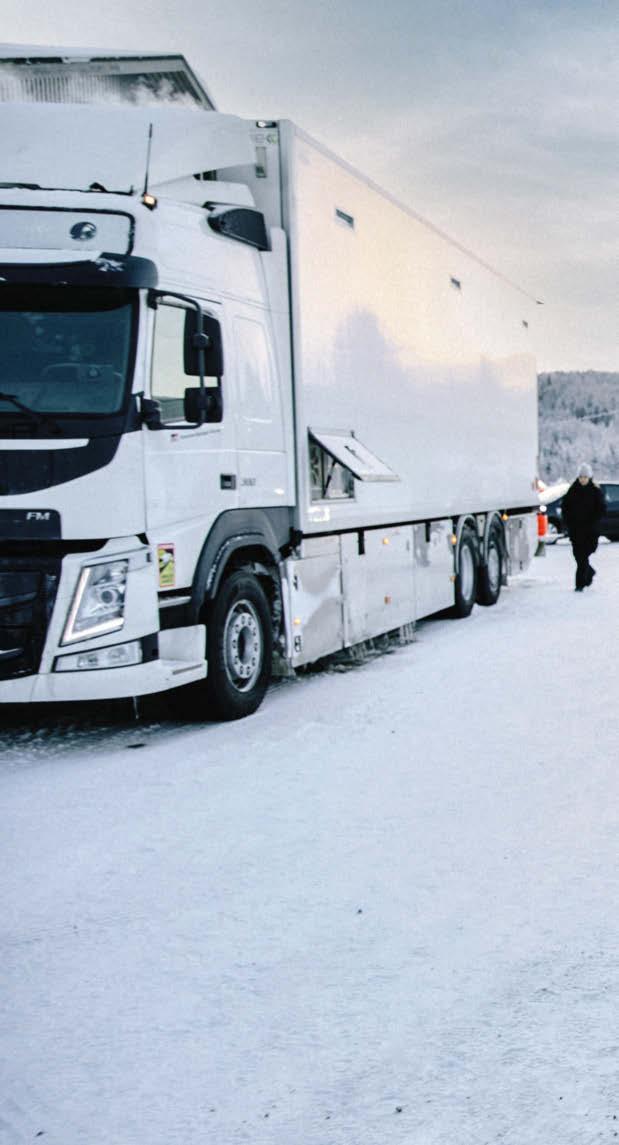
of the quickest in his field; a works driver for Peugeot, Mitsubishi, Seat and Škoda, he won the Swedish Rally in 2001. Today, aged 56, he looks much the same as he did then: greyer, more wrinkles around the eyes, but still tall, still slim, still calm. “I kept crashing,” he admits of a career that never quite took flight and, in his own words, remains something of a disappointment. “And later on, there was a hierarchy in the team that I had
to respect.” That’s his diplomatic way of saying that his teammate, Marcus Grönholm, was slated to be world champion (he took the driver’s title in 2000 and 2002, the last Finn to do so before Loeb and Ogier’s 17-year domination of the sport) and Harri was his wingman, even though he knew what it took to be a champion himself. But by then Harri Rovanperä had already started on another project.
“I’ve never had idols, but I have always looked up to my father”
Harri inducted Kalle to vehicles early. At three he began riding motorcycles; at the age of six he was allowed to drive a car for the first time. “[Harri] taught me that the car had a steering wheel, an accelerator and a clutch, then told me to get on with it,” recalls Kalle. On YouTube you’ll find a video – with more than a million views to date –of an eight-year-old Kalle drifting and donuting a small car converted for
rallying around forest lanes, country roads packed with snow, and over a frozen lake. From outside the car, it looks as if an expert is at the wheel, and footage inside the vehicle shows there is – the youngster’s cool focus, his effortless shifting of the stick, and the brute physicality and precision with which he counter-steers the wheel is simply astonishing. “For safety’s sake, it was on snow and ice to reduce the
speed,” says Harri, as if to handwave away this supernatural display of ability.
Next, Harri bought the little YouTube star his first real rally car, a Citroën C2 R2 Max. At the age of 10, Kalle competed at rally sprints in neighbouring Estonia without a co-driver. “I never had to persuade him to race,” says Harri. And then the seemingly inevitable happened. “I completely lost interest in rallying when I was 12,” says Kalle. “Didn’t even

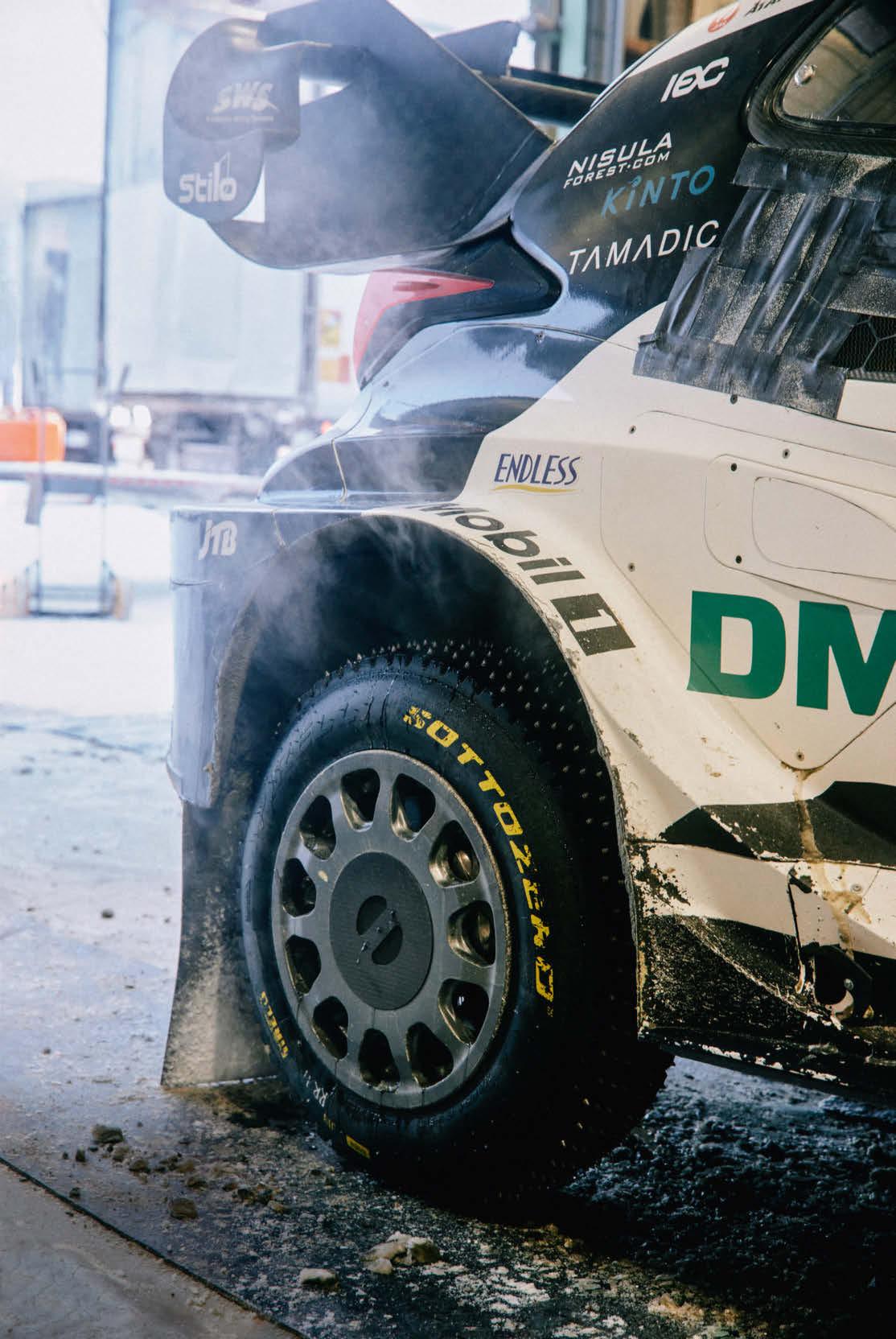 Gripping stuff: tyres with tungsten-tipped metal spikes – known as ‘Sweden spikes’ by the WRC drivers – are compulsory for that country’s rally, staged in frozen February
Gripping stuff: tyres with tungsten-tipped metal spikes – known as ‘Sweden spikes’ by the WRC drivers – are compulsory for that country’s rally, staged in frozen February
look at the car for nine months. At that time, I was doing what other children do.”
But, says Harri, some time before Christmas that year Kalle came to him saying that he wanted to get back on the horse. So Harri towed the Citroën all the way to Lapland, the northernmost region of Finland, and Kalle got in. Speaking metaphorically, he hasn’t climbed out since. A special permit from the Latvian Automobile Federation allowed him to take part in their national championship at 15. Kalle was so young that on the connecting stages his codriver had to take over, as driving on actual roads required a licence. He went on to win the Latvia Rally three times. At the age of 16, he was the youngest driver to claim a national open-class rally championship in any country.
“You could see Kalle had that certain something – by the time he was 15 or 16, he was already faster than me,” remarks Harri. “He’s completely different from the generation we were back then: much smarter, more focused on the goal, and incredibly mature for his 22 years. At most, he might get his calmness in extreme situations from me.”
The evolution from the Harri-like Finn to the Kalle-like Finn is exemplified in the way they speak. Kalle’s English is fluent and urbane; Harri’s comes with a strong accent and plenty of infinitives that mark out a Finnish sisu driver. Sisu is not easily translated except through the personalities of Harri Rovanperä and other native rally drivers. It’s a part of their national character, a cocktail of grit, bravado and perseverance, of sticking to a task until you succeed. We might call that stubbornness, but it’s so much more. German-born Finnish author Roman Schatz describes it in his 2005 book From Finland with Love as “the word that explains Finland”.
Sisu is perhaps the reason Finland has produced so many exceptional racing drivers, from Formula One champions

Mika Häkkinen and Kimi Räikkönen to World Rally champs Ari Vatanen, Juha Kankkunen, Tommi Mäkinen and Marcus Grönholm. There’s a saying in the world of motorsports: “If you want to win, hire a Finn,” and it’s true. A country 1.4 times the size of the UK, but with a population 12 times smaller, Finland has produced more motorsports champions per head than any other. It’s in their genes.
It’s also in the soil. To better understand the Finns’ passion for racing, and perhaps
the nature of sisu, we need to consider the environment that nurtures it. Near every town are country lanes covered with loose gravel in the summer, ice in the winter, and it’s a rite of passage for many to master driving on these roads before they’ve even hit their teens. Folk racing – a low-budget form of rallycross in old, converted road cars – is a national pastime, a full-contact sport on gravel and tarmac circuits, with entrants as young as 14. Mentoring is also deeply ingrained in Finnish racing culture: AKK Motorsport, an organisation that governs more than 320 national automobile clubs, runs training camps for young rookies looking to enter karting – notably, every Finnish F1 driver started out in this sport – and rallying. Räikkönen is one such alumni from these coaching programmes. It’s also a torch passed from generation to generation – Keke Rosberg, winner of the 1982 F1 World Championship and father of 2016 F1 World Champion Nico Rosberg, mentored Häkkinen.
While Kalle grew up learning his craft on closed roads, with security checkpoints and ambulances on standby, he notes that Harri honed his rallying skills on deserted forest roads, at night, on the sly, while friends distracted the village policeman. “I’ve never had idols,” says Kalle. “But I’ve always looked up to my father.”
The roads in Korpilahti, 26km south of downtown Jyväskylä, are thick with snow. As is customary in Finland, they meander up and down, so naturally Kalle Rovanperä’s Toyota Yaris is in sixth gear. A look at the speedometer shows 180kph. Even with the knowledge that there are centimetrelong spikes on the tyres, the pace at which trees whoosh past is terrifying. That feeling only intensifies as Rovanperä approaches the brow of a hill, not headon but at a slight leftward angle. All four wheels leave the ground and, for a moment, everything goes quiet in the car. Then it comes back down to earth and in a single, fluid, economical movement he straightens the car back up. There’s no judder, no lack of rhythm. Perhaps that’s what stops uninitiated co-drivers panicking – the supple, almost gentle way Rovanperä handles his Toyota. Like a Finnish maestro playing a finely tuned 36-string kantele.
“I first drove here when I was 12,” says Rovanperä. “Maybe that explains
Since his WRC win, Rovanperä has got used to being a national hero
my early success. I may be young, but I’m experienced.” At the highest tier of the WRC, he has only had to retire from four races. Compare that with his fellow drivers, most of whom write off cars for years before discovering where the limit is. “Maybe I drive with my brain,” Rovanperä adds, grinning. This doesn’t come across as arrogant, more a realistic assessment of his abilities.
The man sitting in the passenger seat is unlikely to get rattled, having been Rovanperä’s co-driver since his WRC2 debut in 2017. This is Jonne Halttunen, some 15 years Rovanperä’s senior, “although you often don’t know which of the two is older,” says Harri, likening the pair to brothers. What led Halttunen, who has been racing professionally since 2011, to put his career, and life, in the hands of a teenager who at the time had no driving licence? “I was a multiple Finnish champion and wanted to become a World Championship professional, and I saw an opportunity to do that by Kalle’s side,” he says, succinctly. “He was already very mature as a teenager. He drives in a way that doesn’t damage the car, and he’s a clever guy all round. We’ve never had an argument. Kalle knows exactly when to attack, and he shows no mercy.”

Halttunen’s assessment is backed up by their team principal, Toyota Gazoo Racing’s Jari-Matti Latvala, himself a Finnish former WRC driver with 18 rally wins under his belt. “Despite his young age, Kalle drove like an adult, but, more importantly, he dealt quickly and honestly with the few problems he did have,” Latvala says, before detailing the characteristics that set Rovanperä apart from his peers. “He can adjust to new cars faster than others. Can take more risks than others in crucial situations and still keep the car on the road. In tough conditions, when others falter, he comes into his own. And he soaks up the pressure.”
This last, seemingly obvious quality is one that Latvala is keen to emphasise. “Despite all of the pressure that we feel
“Kalle knows when to attack,” says his co-driver. “He shows no mercy”


Taking the wheel: Harri says his son surpassed his skill by the age of 15.
Kalle considers his father his idol [as a team], for a driver that pressure is something else. I know that from experience. When there’s an opportunity to win, it does something to a driver’s mental state. I’ve only seen Kalle nervous once, and that was when he was going for the World Championship in New Zealand.”
Going into that weekend on the last day of September 2022, Rovanperä already had the title firmly in his sights, but not yet in the bag. With two further rallies still on the calendar, to seal the deal he needed to finish seven points clear of his closest rival, Estonian Ott Tänak (incidentally the only driver to break Ogier and Loeb’s long clean sweep, when he won the 2017 WRC). And although Rovanperä had stormed through the season with five wins, his last two events had revealed his fallibility. In Belgium in August, he’d barrel-rolled his car on the first day, and three weeks later, in the Greek Rally, he finished a disappointing 15th, shortening his lead further.
Adding to the stakes, Rovanperä was first to start on the Friday in Auckland, a significant disadvantage as it meant
he’d be the one ‘road cleaning’ the course of loose gravel and paving out lines for everyone else. He finished the day in fourth, 7.2 seconds down on Tänak, who went to bed that night in first place. It was time, as Latvala says, to soak up that pressure. Rovanperä dug deep into his sisu. “I rally to win – I don’t care by how much,” he says of his methodology.
Two important events happened overnight. First, Rovanperä turned 22 years of age. Second, it began to rain heavily – a birthday gift from the heavens for a young man bred in uncompromising conditions. Starting in seventh, he performed impeccably in the downpour, finishing top, or close enough, of every stage, while others erred. This took him into Sunday 29 points ahead of the driver in second place – his teammate and reigning world champion Ogier. In third place sat Tänak. The two men who Rovanperä had – from afar – watched
rule his world since he was 13. The time had come for a new world order, and he’d staked his claim on it.
On the last day’s final Power Stage, Rovanperä needed only to come fourth to claim the world title, but he won it anyway. One day after his 22nd birthday, and in just his third WRC season, Kalle Rovanperä was crowned world champion – the first Finn to return the title to his nation in two decades.
And Halttunen? He was rewarded for his perseverance – his sisu – in riding next to Rovanperä for the last 12 years, his dream of making it onto the world stage far, far exceeded. Rovanperä cannot recall the words he said to his co-driver in that moment of history, but Halttunen can.

“I remember exactly what you said,” he says, turning to Rovanperä. “‘Perkele!’” To the uninitiated, it might sound like the name of some fine liquor, but it is, in fact, an expletive that one would not use in polite company. However, much like great motorsports and wild country roads, the word is universally understood and enjoyed by everyone, of every generation, in Finland.
Instagram: @ kallerovenpera
Aged three, he was riding motorbikes; by six, it was cars



If you’re remotely interested in triathlon, you’re likely aware that Kona is home to the iconic Ironman World Championships – an epic 3.8km swim, 180.2km cycle and 42.2km run across the volcanic landscape of Hawaii’s Big Island. In my time, I’ve done four fulldistance Ironman races and countless 70.3 (half-distance) events. It proved the perfect springboard to my present career as an ultrarunner, but had never led me to Kona. So when Apple invited a select group of international athletes to test their Apple Watch Ultra in this adventure paradise – and I made the cut – I jumped at the chance.
So, on the fourth day of this trip, I found myself grinning like an idiot as Josh Crosby and I rode our bikes along a stretch of Ironman’s famous cycle route, the Queen Ka’ahumanu Highway – or ‘Queen K’ as the locals call it – to Waikoloa Village. I’d floated the idea only last night to my new-found buddy Josh, a former world champion rower, Ironman, pro ultra-endurance athlete and now a
trainer for Apple’s Fitness+ programme, and after some gentle cajoling he’d agreed to a gravel-bike mission up towards the imposing peak of Mauna Kea.

Colloquially known as ‘Mauna a Wakea’, or the White Mountain, this dormant volcano rises 4,207m from the sea below. While its elevation from ground level is substantially lower than Mount Everest’s 8,849m, Mauna Kea rises around 9,330m from its lowest point in the Hawaiian Trough beneath the Pacific Ocean, making it the planet’s tallest mountain when measured by ‘dry prominence’ (from its base on the Earth’s crust).
The itinerary hadn’t afforded me time to summit this tropical giant, but as we turned off the highway onto gravel paths I was mesmerised by glimpses of its summit peeking through the clouds. “Another time,” I gestured to Josh as we meandered higher through the unforgiving terrain. “Count me in,” he laughed.
The past three days have been a whirlwind of adventure, beginning with a crack-of-dawn solo run north along the coast to Hapuna Beach State Recreation
“While lower than Mount Everest from ground level, Mauna Kea rises from the Hawaiian Trough beneath the Pacific Ocean, making it the planet’s tallest mountain”
James Poole, ultrarunner
Treasure island: Poole’s Hawaiian adventure hotspots

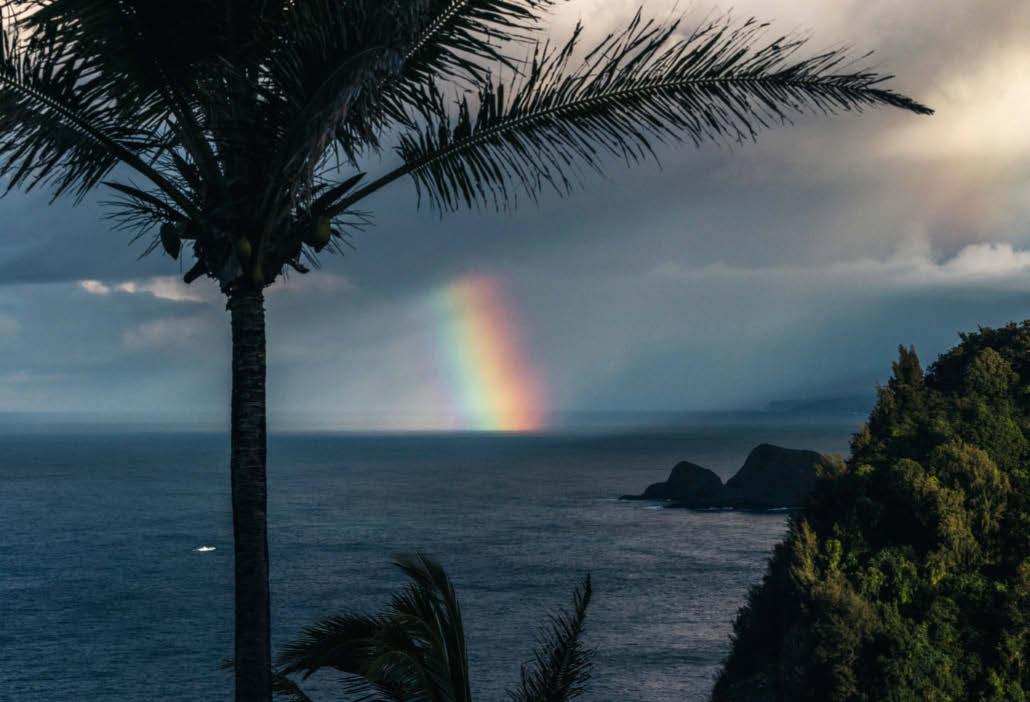 Paradise found: the epic view from Kona’s most northerly point; (opposite) gravel biking above Waikoloa Village; (opening page) King’s Highway Foot Trail
1. Mauna Kea
2. Kohala Forest Reserve
3. Hapuna Beach State Recreation Area
4. Waikoloa Village
5. Bike Works Beach & Sports
Paradise found: the epic view from Kona’s most northerly point; (opposite) gravel biking above Waikoloa Village; (opening page) King’s Highway Foot Trail
1. Mauna Kea
2. Kohala Forest Reserve
3. Hapuna Beach State Recreation Area
4. Waikoloa Village
5. Bike Works Beach & Sports
Over the years, I’ve run a lot of adventure watches through their paces (literally). The user experience of the Apple Watch Ultra compared with the Garmins out there is like night and day, and the build quality is impressive. However, for the kind of multi-day runs I face, it’s not the ideal endurance watch – yet.
First, there’s the battery life. With all its functions
on, the Ultra can manage 12 hours of continuous activity – respectable for everyday exercise. And in low-power mode I squeezed 17 hours of activity out of it – plenty for a road marathon, but not for hundred-milers in the mountains. There’s an even more extreme low-power ‘workout’ mode that turns off most run metrics and reduces your GPS and heart-rate readings
Area. One of my favourite things to do when arriving in any new place is to grab my running shoes, take a glance at a map and head out the door with no plan other than to explore and shake off the jet lag. Soon I was heading north, following sandy beach paths and razor-sharp volcanic rock trails, content with my own company and the joys of seeing the world awaken from its slumber, a tranquillity far removed from my home life in chaotic east London.
I’d planned my route back to civilisation to be relatively easy: I’d keep the Pacific Ocean on my left on the way out and to my right on the way back. However, the Ultra allows you to set waypoints en route, and I was able to follow the breadcrumb trail back to safety – or, in my case, breakfast. Unlike some other adventure-oriented GPS watches, however, it’s not possible to natively upload and follow a GPX route (basically an Excel spreadsheet showing three-dimensional route info, including elevation and topographical details). There are paid apps that fill this gap,
to every 90 seconds but increases battery to around 60 hours. This made my distance readings inaccurate, although the speed with which it collects your GPS (around two seconds) is stunningly fast. The 86-decibel siren – a high-tech whistle – is nice, but then, if you’re conscious you could cry out, and if you’re not you can’t activate it anyway. However, the Backtrack and SOS by Satellite features, the latter of which relays your location to emergency contacts (but requires you to have an iPhone 14 or 14 Pro with you), could have saved my life last year. While running the 550km Speed Project Solo in March 2022, I found myself in a precarious situation on an icy Mount Baldy in California’s San Gabriel mountains, with no mobile reception. Had I fallen, there would have been no way of getting help. Thanks to this, the ability to contact emergency services by satellite is now a standard part of my adventure kit.
sand or pebbles, the sight of black sand never fails to amaze. Hiking through the vibrant tropical undergrowth revealed an unspoiled cove and a perfect spot to end the first day’s pursuits.
Over 20-plus years of being involved in adventure sports, I’ve tried a range of activities, from crossing the Gobi Desert to summiting Mont Blanc and surfing glassy left-hand breaks in El Salvador. That said, I’ve always been most at home above water, and my mediocre swimming ability is probably the main reason I no longer compete at Ironman.
Having not strapped a tank to my back in years, I was apprehensive to find myself booked on a trip to try out the Oceanic+ app, a recreational dive computer created in partnership with Huish Outdoors (the diving-tech company founded by scuba pioneer Bob Hollis, who designed some of the earliest dive computers and sadly passed away in January this year, aged 85). Fortunately, I was undertaking snuba – a variant of scuba where the tank floats on a raft above you – removing the need for a refresher course or, in fact, any prior dive experience. And while the length of the hose limits your depth and therefore the chances of getting the bends, there’s still the risk of barotrauma to the ears or lungs even at shallow depths.
James Poolebut it limits the watch’s potential when heading off the beaten track.
With trail shoes swapped for hiking boots, we headed past Hawi – the Ironman bike-leg turnaround point on the Queen K – and onto the Kohala Forest Reserve and a walk down to its volcanic sand beach. Considering most of our beaches in the UK are golden
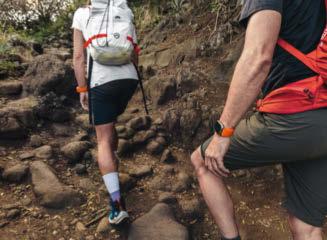
Without the burden of gear and technique, we descended to eight metres, deep enough to spot shoals of butterfly fish, bluestripe snapper and parrot fish swimming amid the coral reef. I’d forgotten how cathartic diving is, and as we motored back to the marina I vowed to get my PADI diving certification and spend more time underwater.
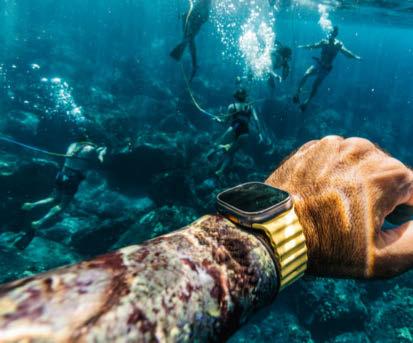
As Josh and I returned our Cervelo Áspero gravel bikes to Bikeworks Beach & Sports on Waikoloa Beach Drive, I reflected on these incredible few days of exploration. While everyone’s idea of paradise is different, for those passionate about the outdoors it would hard to argue against Hawaii being anything but the epicentre of adventure. A pyramid of nature from the depths of the Pacific to the snow-topped peak of Mauna Kea, it’s a nirvana for runners, hikers, surfers, cyclists and divers alike. As I board my plane, I can’t help but say out loud, “Mahalo Hawaii,” and, “A hui hou!”
Thanks, Hawaii. Until we meet again… James Poole has run some of world’s most challenging foot races including Ultra-Trail du Mont-Blanc, The Speed Project Solo and the Gobi 400, and is a member of The North Face Explorer Team; Instagram: @jamesdpoole
An ultrarunner’s take on the Apple Watch UltraHawaii is a nirvana for runners, hikers, surfers, cyclists and divers alike

Scenario: you’re a New York police detective who’s flown into Los Angeles hoping to reconcile with your estranged wife. But you’ve inadvertently gatecrashed her company’s Christmas party at their high-rise office. And you’re not the only one. A group of international terrorists led by a criminal mastermind who looks and sounds a lot like famous actor Alan Rickman has taken everyone hostage. However, you’ve managed to secure one of the terrorists’ walkie-talkies (and a machine gun). As the only person with a direct line to the captors and the hostage negotiators outside, what do you do?
Hopefully you wouldn’t attempt what Bruce Willis’ character John McClane did in the 1988 movie Die Hard –an approach best described as aggressive negotiation (spoiler: the building insurance wouldn’t cover it). Rupert Godesen could offer a more diplomatic solution. Godesen (pictured, inspecting a landmine) is the founder of HASP Training, a company that delivers Hostile Environment Awareness Training (HEAT). The author of books such as Travelling Safely Overseas, and with more than 30 years’ experience serving in Bosnia, Iraq and Afghanistan as a British Special Forces reservist, he has trained BBC foreign correspondents in everything from dealing with “stroppy policemen and vehicle checkpoints” to being taken hostage.

Thankfully, his first piece of advice is that the latter scenario is very uncommon. “Kidnapping people for the purpose of ransom is a huge logistical challenge,” he says. “Why would you do that when you can get into cybercrime and steal people’s money in your pyjamas?”
However, Godesen’s negotiation tactics can also
From breaking the ice to saving your life, this guy can get you out of any sticky predicament
be applied to more mundane situations, from tricky job interviews to awkward party conversations. Here’s how to talk yourself out of any uncomfortable situation…
The best way to get out of a difficult confrontation? Avoid getting into it. “Appreciating someone else’s position, walking in their shoes and not being an arsehole will hopefully prevent you from getting into trouble in the first place,” explains Godesen. Showing respect – things like “putting your phone away, and taking sunglasses off when looking someone in the eye” – can work wonders.
“If you’ve thought about all the things that might go wrong, it’s a lot easier to remain calm when they do; it makes you ambush-proof,” says Godesen. “Unlike animals, we’re blessed with imagination, so rehearse [scenarios] and take steps to mitigate problems.” And no, being ‘too much of a perfectionist’ won’t cut it for that ‘greatest weakness’ job interview question.
Godesen warns against trying to lie your way out of a problem. “When you do fuck up, just stick your hands up and say, ‘I’m sorry, that was my fault,’” he says. And don’t think you can get away with an honest face – body language is our biggest tell. “Most people lie with their feet – they start pointing towards the exit,” Godeson explains. “You’re feeling uncomfortable and literally looking to leave.”
Even if someone is right up in your face, it’s still possible for you to diffuse the situation. “Neuro-linguistic programming is the study of non-verbal communication,” says Godesen. “You can affect a change in someone simply by altering your voice. If you lower your tone and say with your body language, voice and gestures that there’s no problem here, they won’t be able to stop themselves calming down.” Eye contact is a critical factor, too: “Don’t stare someone out. Have a blank, supplicatory look – look at their chest or away.”
Godesen recommends exercising caution, but if your argument is solid and you feel safe, it’s possible to regain control of the situation by going on the offensive. “One of my clients was in Japan when someone on the Metro grabbed her bum,” he recalls. “She turned like lightning, grabbed the man’s hand and said out loud, ‘This guy just felt my backside.’ He went the colour of beetroot. If you know your situation, you can get away with more.”
Rupert Godesen is the managing director of HASP Training and author of Travelling Safely Overseas; hasptraining.co.uk
“You can affect a change in someone simply by altering your voice”
Rupert Godeson, expert negotiator



“
When people hear the speeds, their minds are just blown.” Tom Bosworth is explaining his response to those who mock his walk. Hips wiggling, arms pumping, he stands out in a (moving) crowd. But his technique is focused on one thing: speed. It’s remarkably efficient, too: the 33-year-old from Sevenoaks, Kent, holds the world record for the fastest mile walked – five minutes and 31 seconds, set at the London Stadium in 2017. To put it into perspective, a sub20-minute 5K requires an average time of six minutes and 26 seconds per mile.
Although Bosworth hung up his competitive walking shoes in August last year, he’s the UK’s most decorated racewalker of the modern era.
Professional races range from 3km to 100km in distance, and competitors must follow two main rules: the leading leg must remain straight until the body passes over it, and one foot must be in contact with the ground at all times. Judges scrutinise technique, and competitors receive a yellow card if either rule is broken. Get three in a race and you’re disqualified.
Bosworth believes this adds jeopardy and ups the stakes when compared with other endurance sports. “People might say, ‘I don’t want to watch a marathon, it’s two and a half hours – that’s boring,’” he says. “Switch over to racewalking. It’s an hour and 20 minutes, and there could be multiple changes at the front, even in the last few laps.”

While he concedes that the technique is, at first, an “incredibly difficult, almost uncomfortable action to make”, racewalking is one of the most accessible and low-impact ways to get in shape, says Bosworth: “It’s a full-body workout. Your core and glutes work so hard to maintain the technique over the distance, so it can get you super-fit.”
“People worry about having both feet off the ground, but that’s only when you’re going at elite-level speeds,” Bosworth says. “The hardest bit is the straight leg – not bending your knee feels counterproductive and your body won’t want to do it, especially if you’ve run before.” Perfecting your foot strike is the easiest remedy for this: “By landing on your heel and pulling up your toes, you naturally straighten your leg.” This also causes a chain reaction in your hips, setting off that well-known wiggle.
As your straight leg passes beneath you, supercharge each step by keeping your foot on the floor as long as possible. “It’s vital to the technique [and rules] and gives you a push-off for speed.” Bosworth also tells beginners to imagine they’re
walking a tightrope, to reduce side-to-side movement.
While your lower half is about rigidity, up top should remain relaxed. With your arms bent 90° at the elbow, pumping from the hips, your torso stays upright, head facing straight ahead. “If your head’s bobbing up and down, you’re probably starting to fatigue, or your technique’s not that strong – you’re not going in enough of a forward direction.”
“Landing with a straight leg puts a lot of torque through your hamstrings, lower back
and core, so you have to be very strong,” says Bosworth. His secret strength weapon?
“I got two of my British records [in 2020] after a winter spent doing Pilates every morning.”
Three rounds of a four-minute plank and side-plank routine were all it took to “transform” him and elevate his performances to previously unseen heights.
You might be tempted to start slowly, but Bosworth believes this isn’t the best approach.
“Do drills at a normal walking pace and [you’ll find your] rhythm,” he says. And don’t get disheartened if you fail to nail it first time: “[I’ve seen] elite runners give it a go and they’re in complete agony for 50 metres, let alone 20 kilometres, because the technique is so difficult.” tombosworth.com
“Racewalking is a full-body workout”
Tom Bosworth, record holder
Retro TV show Stranger Things (pictured) introduced a whole new audience to the OG of RPGs: Dungeons & Dragons. Keen to delve further? Grab a torch…

Unleashed onto the world by Americans Gary Gygax and Dave Arneson in 1974, Dungeons & Dragons (D&D) is a unique mix of board game, war game and improv theatre and was the first role-playing game (RPG) that allowed players to control individual characters rather than entire armies. Big on fantasy, it was lapped up by Tolkien-addled teenagers keen to live out heroic quests against multiheaded monsters using pen, paper, rule books and a fistful of differently shaped dice.
D&D’s fortunes have ebbed and flowed since launch. In the ’80s, Christian evangelicals claiming the game promoted witchcraft and Satanism didn’t prevent it becoming a global phenomenon, even scoring its own Saturday-morning cartoon, before crashing down to Earth a decade later. But a 2014 relaunch heralded a renaissance and it now boasts millions of fans worldwide, with a live-action film, Dungeons &
Dragons: Honour Among Thieves, starring Hollywood A-listers Chris Pine and Hugh Grant, hitting cinemas this month. D&D is now firmly part of the cultural cool.
But how does a Level 1 newbie with zero Experience Points get on board? Games take the form of stories in which players create their character (including race, occupation, abilities and a few dice-rolled starting stats). Led by a Dungeon Master (DM) – part referee, part storyteller, part circus ringmaster – players navigate the DM’s story, overcoming challenges with teamwork, logic and the throw of dice. There are rarely winners or losers in the classic sense, and games seldom end in one session; in fact, some have been known to never end.
One person who knows the lay of the kingdom is Matthew Mercer. The 40-year-old American voice actor is the most famous DM alive today

and co-founded the YouTubebased D&D stream Critical Role. Here, he shares how to conjure the best from your experience…
With its multiple rule books and 20-sided die, D&D may seem daunting, but Mercer says it’s only as complicated as you want it to be. “Rules are there to help, not bind or hinder,” he explains. “Any
complicated, conflicting or annoying rules can be bent or ignored to keep the joy rolling.”
Role-playing is a pillar of D&D. “Many first-timers create characters not too dissimilar to themselves,” says Mercer. “But I challenge you to make something very different and see how far you can lean into it.” This could help you break out of your bubble and see things differently. Your roleplaying needn’t be limited to a silly voice, either: “Twisted postures, expressions and small props can all be extremely effective tools.”
Whether a DM or a player, listening is a useful skill when working in groups. “It can be very easy to get lost in your own thoughts and plans. But when you’re just as invested in the other players and their characters and you let yourself role-play reflexively, that’s when the real magic happens.”
The role of DM may be akin to godhood in your friendship group, but anyone can do it. Mercer describes his first DM experience as “clumsy, wild and altogether absurd”, but he stuck with it. He believes RPGs can build creative group skills in a way few other activities do. “Getting lost in my imagination and watching these worlds come to life in front of me, then weaving in complications and stakes for my players to encounter and alter through their own cleverness, is a joy I cannot express.” Not sure how to craft your first adventure? He uses his love of mythology as a foundation and lets his creativity flourish from there. Check out Matthew Mercer’s YouTube channel (@criticalrole) and follow him on Twitter: @matthewmercer. Dungeons & Dragons: Honour Among Thieves is at cinemas nationwide from March 31
“Rules can be bent or ignored to keep the joy rolling”
Matthew Mercer, Dungeon Master
To fully realise the metaverse requires bold vision. These goggles deliver exactly that


Virtual reality is the future. It’s a promise we’ve heard since the VR craze of the early 1990s, when big, heavy headsets delivered bouts of motion sickness caused by juddering tech not ready for mass consumption. Today, it’s a different story: consumer kit such as Meta Quest 2 and PSVR 2 offers a slick and immersive experience. But it turns out this was just a stepping stone to the true future: ‘mixed reality’. Imagine working at your actual desk but typing on a virtual laptop, or racing Mario Karts around your kitchen floor. To deliver this effectively requires something called ‘passthrough’ – cameras on the front exterior,
capturing your surroundings in stereoscopic clarity – but most affordable devices today deliver a grainy, monochrome image. Not the HTC Vive XR Elite. This light, all-in-one headset (no need to connect it to a computer or console) feeds a full-colour, 110° view of the real world, with six degrees of freedom (full directional and rotational tracking of your head). It’s our ticket to the metaverse – a seamless blend of the real and the virtual where you can play a digital version of the board game Catan on your own coffee table with avatars of random people you’ve never met in person. This, my friends, is the future. vive.com
Getting stuck at the trailside with a puncture – and a long walk back to civilisation ahead of you – is enough to make anyone want to learn how to fix a flat tyre. But why stop at basic bike maintenance skills?
Learning how to fix your ride’s various components has never been easier thanks to a wealth of instructional videos on YouTube, and this new-found knowledge will help you, or your riding buddies, get out of a jam whenever something breaks.
Plus, investing time and money to keep things running smoothly is a win-win, leaving you with that brand-new bike feeling every session, and no more expensive bills or missed riding days.
While a solid set of Allen keys is a good start, it’ll only get you so far. Here are the specialist tools you need to fully kit out your DIY armoury…

Tyres should be the only contact point between you and the ground, and their pressure can make or break a ride. Too much air will have you bouncing off every root and rut, while not enough can risk damaging rims. Channel your inner Goldilocks and get things running just right
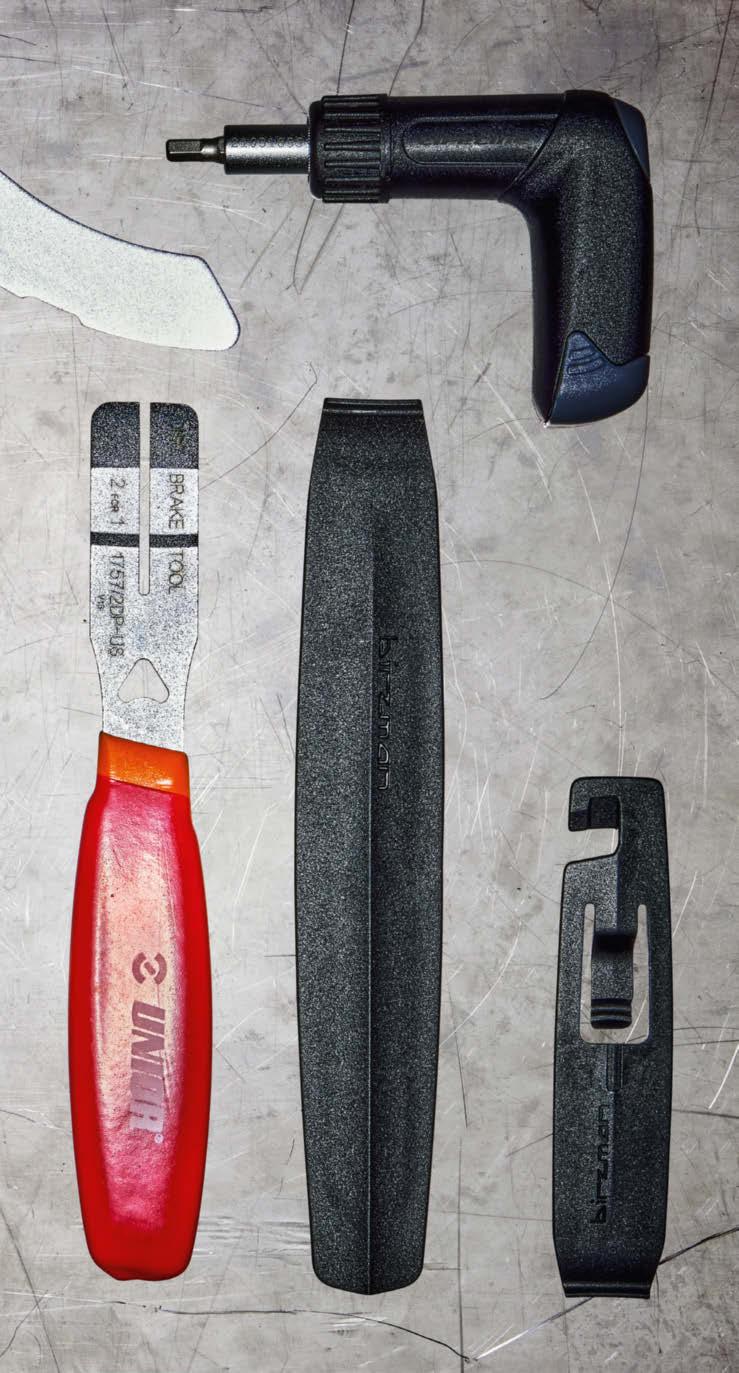
with this super-accurate digital pressure gauge. Silca TRUTH Pressure Gauge; silca.cc
While disc brakes have revolutionised stopping power and control in all conditions, they come with their own complications. The most common is caliper rub on rotors, which not only speeds up wear but also sounds like the sword-fight scene from a medieval movie when applied. To fix it first time, slot this nifty tool over the rotor and take the guesswork out of brake caliper realignment. Birzman Razor Clam; birzman.com
Splashed the cash on a carbon-fibre frame? You need a torque wrench in your life. The material is a bit precious and will crack (literally) if put under too much pressure. Remain within the little Nm (Newton meter) numbers listed on every bolt and clamp, though, and you and your highly strung steed will get on just fine. LifeLine Essential Mini Torque Wrench; hotlines-uk.com
If you’re replacing hydraulic disc brake hoses, you’ve advanced to pro-level DIY mechanic. Before giving up the day job and going solo, you might want to spend your final paycheque on this barb-fitting device, which makes one of the most precise and fiddly parts of the process as simple as twisting two knobs. LifeLine Pro Hydraulic Hose Needle Driver; hotlines-uk.com
Fixing a tubeless tyre that won’t reseal is a messy rite of passage involving sealant, swearing and – more often
than not – sticking in a good old-fashioned inner tube. This smart three-in-one system solves these problems, with everything you need (plugs, a CO2 cartridge and a hand pump) in a compact package.
Lezyne CNC Tubeless Drive; ride.lezyne.com
If realigning your brake caliper doesn’t stop the screeching, it’s time to look at the rotor. The metal discs can become warped over time, and even the slightest bend can send your bike spiralling. This truing wrench makes the job of getting the rotor back on the straight and narrow super-simple, consigning irritating squeaks to the past. Unior 2-in-1 Disc Brake Tool; uniorusa.com
The perfect seal needed for tubeless tyres makes changing them an absolute nightmare – an ordeal that often requires a Herculean degree of brute strength and hands of steel merely to get them onto the rim. Protect your fingertips – and your sanity – with this neat installation and removal tool, which taps into the physics of fulcrums and levers to pop that pesky tyre on in a cinch. Birzman Wedge Wedge 2.0; birzman.com
The ability to adjust gears with a twist of a barrel here and the quarter-turn of a screw there seems nothing short of witchcraft, but it’s something that can be learned by even the biggest muggle. Before breaking out your book of gear-shifting spells, it’s worth checking the rear hanger’s alignment first, as a slight tweak can get things running smoothly. LifeLine Pro Gear Hanger Alignment Tool; hotlines-uk.com
Wheels take a beating offroad, and it’s not uncommon for rims to get knocked out of shape after spills or casing a landing. While a slightly wonky
wheel can easily be trued with a spoke key, it’s important to check that the hub in the middle is centred using a wheel-dishing gauge, keeping your handling on point (and preventing any further mishaps). Abbey Bike Tools Harbor Gauge Wheel Dishing Tool; abbeybiketools.com
Ensuring that bearings remain grime-free and greased is one of the most basic ways to self-service your bike. Getting at the ones locked away in the bottom bracket isn’t straightforward, though. This multipurpose wrench fits the bill and will have you breaking them out for a refresh or replacement in no time. Wolf Tooth Pack Wrench Kit; wolftoothcomponents.com
Top tip: when installing pedals, it’s useful to remember that the left side is reversethreaded. To tighten, slot the spanner onto the pedal’s spindle and turn the cranks back. So think ‘crank bank, pedal on’ and not the standard ‘lefty-loosey, righty-tighty’. If only all bike maintenance tasks had such catchy phrases… Upgrade Bikes Pedal Spanner; dmrbikes.com

Even if you clean your chain religiously after every ride, there will come a point when it and the cassette will become stretched, worn and require replacing. Skip the chain whip and its fiddly fastening; opt instead for this cassette wrench, which uses three pins to hold it securely in place when applying some torque. Unior Cassette Wrench; uniorusa.com
Learning how to fix your ride’s components has never been easier

Al Weiwei is perhaps China’s most famous living artist-activist; his works include Beijing’s 2008 Olympics stadium as well as films that have got him thrown in prison. But, during lockdown, Ai ruminated on how items we consider worthless take on new value. That’s what this exhibition represents, featuring a toilet roll and takeaway container sculpted from marble, as well as social commentary pieces like a Han dynasty urn bearing the Coca-Cola logo, and a ‘field’ of fragments from sculptures destroyed when his studio was demolished by the Chinese state in 2018. “The visitor is challenged to think about what we value,” Ai says, “and what we destroy.” The Design Museum, London; designmuseum.org


Rotorua (Mãori for ‘second lake’) was so-named by the early indigenous explorer Ihenga, who discovered this geothermic expanse of water within a volcano caldera on New Zealand’s North Island. Surrounded by hot springs and the redwood-populated Whakarewarewa Forest, it’s a place of beauty, and, for attendees of this stop on the Crankworx World Tour – the mountain-bike competition series – a playground of epic trails. Whistler in Canada may be the spiritual home of Crankworx, but there’s a reason why Rotorua is called its soul. Catch it live on Red Bull TV. redbull.com
In 2004, MC, dancer and playwright Jonzi D wanted to bring British hip hop to the world, so he created an annual celebration that would instead bring the world to British hip hop. Nineteen years on, this three-day dance-as-theatre festival is as groundbreaking as ever, featuring a global roster of poppers, lockers, B-boys and B-girls, renowned graffiti artists and DJs. One of the most vital events on the hip-hop calendar anywhere. Sadler’s Wells Theatre, London; breakinconvention.com

At 25, few of us know what we want in life, but Kanoa Igarashi does. Since the age of three, when his father – having relocated the family from Tokyo to California – took him surfing in their new home of Huntingdon Beach, aka Surf City, the JapaneseAmerican has had one dream: to lift the World Surf League Championship Tour (WSLCT) trophy, the sport’s most elite prize, contested by the year’s best 34 surfers. He’s on course: at 14, he became the youngest surfer to win the US National Championships for under-18s; at 20, he was the youngest rookie in the WSLCT. This follow-up to his 2021 film (also available on Red Bull TV) tracks his campaign for the 2023 title. redbull.com
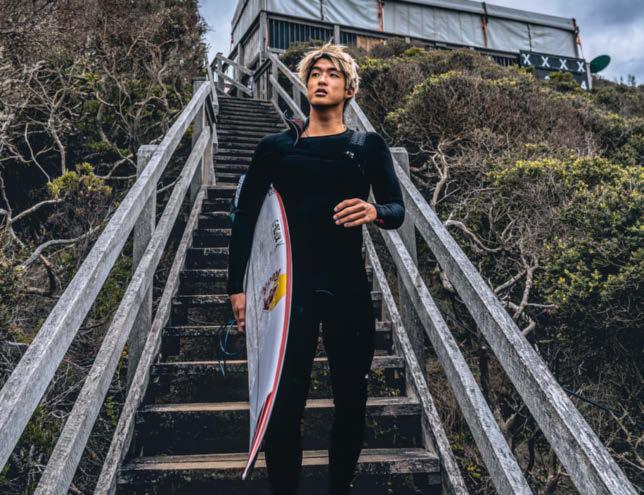
For gamers, those letters mean only one thing: the four letters on a QWERTY keyboard that are mapped to a player’s movement controls in a first-person shooter. It’s also the name of the main consumer event of the annual London Gaming Festival taking over the capital. Try out pre-release games, attend panels by content creators, and even receive expert advice on a career in the industry. The Truman Brewery, London; wasdlive.com

Johnny Vegas may not be the first name that comes to mind when you think of glamping, but the Lancashire comic has curated his own vision of it, converting, among other vehicles, a German fire truck, US school bus and even a helicopter into posh camper vans. The perfect stay when enjoying the summer series of live comedy and music in the grounds of this stately home. Melbourne Hall, Derbyshire;melbournehall.com
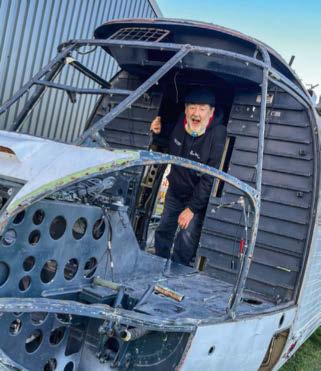
Editor Andreas Kornhofer
Editor-in-Chief
Andreas Rottenschlager
Creative Directors
Erik Turek (manager), Kasimir Reimann
Copy Chief
David Pesendorfer
Art Directors
Marion Bernert-Thomann, Miles English, Tara Thompson
Designers
Martina de Carvalho - Hutter, Kevin Faustmann-Goll, Carita Najewitz
Photo Editors
Eva Kerschbaum (manager), Marion Batty (deputy), Susie Forman, Tahira Mirza, Elena Rodriguez Angelina, Rudi Übelhör
Global Content
Tom Guise (manager), Lou Boyd
Head of Audio
Florian Obkircher
Managing Editors
Ulrich Corazza, Marion Lukas -Wildmann
Head of Publishing Management
Sara Car-Varming
Channel Management
Ivona Glibusic
The Red Bulletin is published in six countries. This is the cover of our US issue for April, which features American pro snowboarding phenom Zeb Powell.

For more stories beyond the ordinary, go to: redbulletin.com
Editorial Director A lexander Müller-Macheck
Head of Media Sales & Partnerships
Lukas Scharmbacher
Head of Co -Publishing Susanne Degn - Pfleger
Project Management Co-Publishing,
B2B Marketing & Communication
Katrin Sigl (manager), Katrin Dollenz, Michaela Kroboth, Teresa Kronreif, Julia Leeb, Valentina Pierer, Stefan Portenkirchner, Bernhard Schmied, Jennifer Silberschneider, Sophia Wahl
Creative Services Verena Schörkhuber-Zöhrer (manager), Sara Wonka, Tanja Zimmermann, Julia Bianca Zmek, Edith Zöchling-Marchart
Commercial Management Co-Publishing

Alexandra Ita
Editorial Co - Publishing Gundi Bitter mann, Raffael Fritz, Michael Hufnagl, Alexander Klein, Irene Olorode, Mariella Reithoffer, Wolfgang Wieser
Executive Creative Director Markus Kietreiber
Senior Manager Creative Elisabeth Kopanz
Art Direction Commercial & Co-Publishing
Peter Knehtl (manager), Silivia Druml-Shams, Erwin Edtmayer, Simone Fischer, Andreea Gschwandtner, Lisa Jeschko, Araksya Manukjan, Carina Schaittenberger, Julia Schinzel, Florian Solly, Sophie Weidinger
Direct to Consumer Business Peter Schiffer (manager), Marija Althajm, Victoria Schwärzler, Yoldaş Yarar
Retail & Special Projects Manager Klaus Pleninger
Advertising Manuela Brandstätter, Monika Spitaler
Production Veronika Felder (manager), Martin Brandhofer, Walter O. Sádaba, Sabine Wessig
Repro Clemens Ragotzky (manager), Claudia Heis, Nenad Isailović, Sandra Maiko Krutz, Josef Mühlbacher
Finance Mariia Gerutska (manager), Elisabeth Maier
MIT Martin Bartmann, Christoph Kocsisek, Michael Thaler
IT Service Desk Maximilian Auerbach
Operations Alice Gafitanu, Melanie Grasserbauer, Alexander Peham, Thomas Platzer, Raphaela Pucher
Project Management Dominik Debriacher
Assistant to General Management Sandra Artacker
CEOs Red Bull Media House Publishing
Andreas Kornhofer, Stefan Ebner
Editorial office Am Grünen Prater 3, A-1020 Vienna Phone +43 1 90221 - 0 Web redbulletin.com
Published by Red Bull Media House GmbH, Oberst-Lepperdinger-Straße 11–15, A-5071 Wals bei Salzburg, FN 297115i, Landesgericht Salzburg, ATU63611700
Executive Directors
Dietmar Otti, Christopher Reindl, Marcus Weber
THE RED BULLETIN
United Kingdom, ISSN 2308-5894
Editor
Ruth McLeod
Chief Sub-Editor
Davydd Chong Publishing Manager
Ollie Stretton
Advertising Sales
Mark Bishop, mark.bishop@redbull.com
Printed by Quad/Graphics Europe Sp. z o.o., Pułtuska 120, 07-200 Wyszków, Poland
UK Office
Seven Dials Warehouse, 42-56 Earlham Street, London WC2H 9LA Tel: +44 (0) 20 3117 2000
Subscribe getredbulletin.com
Enquiries or orders to: subs@uk.redbulletin.com.
Back issues available to purchase at: getredbulletin.com
Basic subscription rate is £20.00 per year. International rates are available. The Red Bulletin is published 10 times a year. Please allow a maximum of four weeks for delivery of the first issue
Customer Service +44 (0)1227 277248, subs@uk.redbulletin.com
THE RED BULLETIN
Austria, ISSN 1995-8838
Editors
Nina Kaltenböck (manager), Lisa Hechenberger, Benjamin Wolf (Innovator)
Proofreaders
Hans Fleißner (manager), Petra Hannert, Monika Hasleder, Billy Kirnbauer-Walek
Publishing Management
Julian Vater
Media Sales & Partnerships
Thomas Hutterer (manager), Michael Baidinger, Maggie Childs, Franz Fellner, Ines Gruber, Moritz Philipp Haaf, Wolfgang Kröll, Gabriele Matijevic-Beisteiner, Yvonne Mensik, Alfred Minassian, Nicole OkasekLang, Britta Pucher, Nicole Umsait, Johannes Wahrmann-Schär, Ellen Wittmann-Sochor, Ute Wolker, Christian Wörndle, Sabine Zölß
THE RED BULLETIN
Germany, ISSN 2079-4258
Editor
David Mayer
Proofreaders
Hans Fleißner (manager),
Petra Hannert, Monika Hasleder, Billy Kirnbauer-Walek
Country Project Management
Lisa Masten
Media Sales & Partnerships
Thomas Hutterer (manager), Michael Baidinger, Maggie Childs, Franz Fellner, Ines Gruber, Moritz Philipp Haaf, Wolfgang Kröll, Gabriele Matijevic-Beisteiner, Yvonne Mensik, Alfred Minassian, Nicole OkasekLang, Britta Pucher, Nicole Umsait, Johannes Wahrmann-Schär, Ellen Wittmann-Sochor, Ute Wolker, Christian Wörndle, Sabine Zölß
THE RED BULLETIN
Switzerland, ISSN 2308-5886
Editor
Saskia Jungnikl-Gossy
Proofreaders
Hans Fleißner (manager), Petra Hannert, Monika Hasleder, Billy Kirnbauer-Walek
Country Project Management
Meike Koch
Media Sales & Brand Partnerships
Christian Bürgi (team leader), christian.buergi@redbull.com
Marcel Bannwart, marcel.bannwart@redbull.com
Jessica Pünchera, jessica.puenchera@redbull.com
Michael Wipraechtiger, michael.wipraechtiger@redbull.com
Goldbach Publishing
Marco Nicoli, marco.nicoli@goldbach.com
THE RED BULLETIN USA, ISSN 2308-586X
Editors
Peter Flax (manager), Melissa Gordon, Nora O’Donnell
Copy Chief
David Caplan
Publishing Management
Branden Peters
Advertising Sales
Marissa Bobkowski, marissa.bobkowski@redbull.com
Tanya Foster, tanya.foster@redbull.com
Todd Peters, todd.peters@redbull.com
THE RED BULLETIN
France, ISSN 2225-4722
Editors
Pierre-Henri Camy (manager), Marie-Maxime Dricot, Christine Vitel Country Project Management
Alexis Bulteau
Media Sales & Partnerships
Yoann Aubry, yoann.aubry@redbull.com
Dave Szych, dave.szych@redbull.com







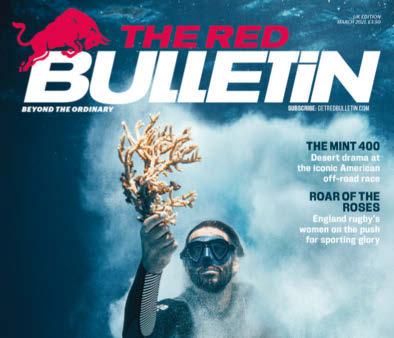
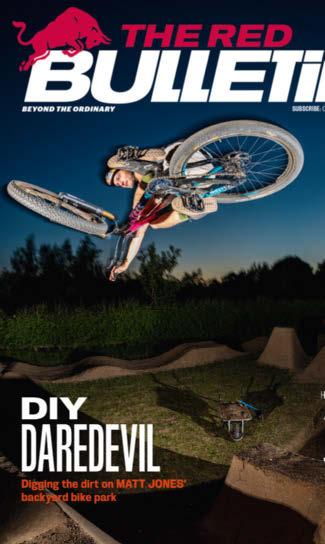
The next issue is out on Tuesday 11 April with London Evening Standard. Also available across the UK at airports, universities, and selected supermarkets and retail stores. Read more at theredbulletin.com




“In my mid-twenties, I lived in the middle of a city and was gifted an old steel road bike, which became my primary mode of transportation everywhere I went within about five miles of my apartment. I used to tell people it changed my life, which is true, but another way to say it might be that it ruined my life, since I got so used to not driving anywhere, and just rolling my bicycle up to a bike rack or signpost near the door of wherever I was going. Some people hate traffic; I hate parking: the search for a spot, the manoeuvring of my big motorised box with wheels, waiting for other people to manoeuvre their big motorised boxes out of my way, craning my neck to try to see well enough to back out of a spot, et cetera. It’s just not nearly as fun, or as easy, as riding a bicycle. Easier to carry a TV or a load of timber home, yes, but not as fun.”
The next issue of THE RED BULLETIN is out on April 11


